
 |
|
|
#1 |
|
All the news that's fit to excerpt
Name: newsie
Location: who knows?
Join Date: Jun 2008 Motorcycle(s): only digital replicas Posts: Too much.
|
[cycleworld.com] - Aprilia Tuono V4 Factory vs. BMW M 1000 R vs. Ducati Streetfighter
In this, our second part of our 2023 hyper-naked sportbike shootout, we put the best from Aprilia, BMW, and Ducati in the ring and then crowned a winner for best hyper-naked.
Click here to view on their site. 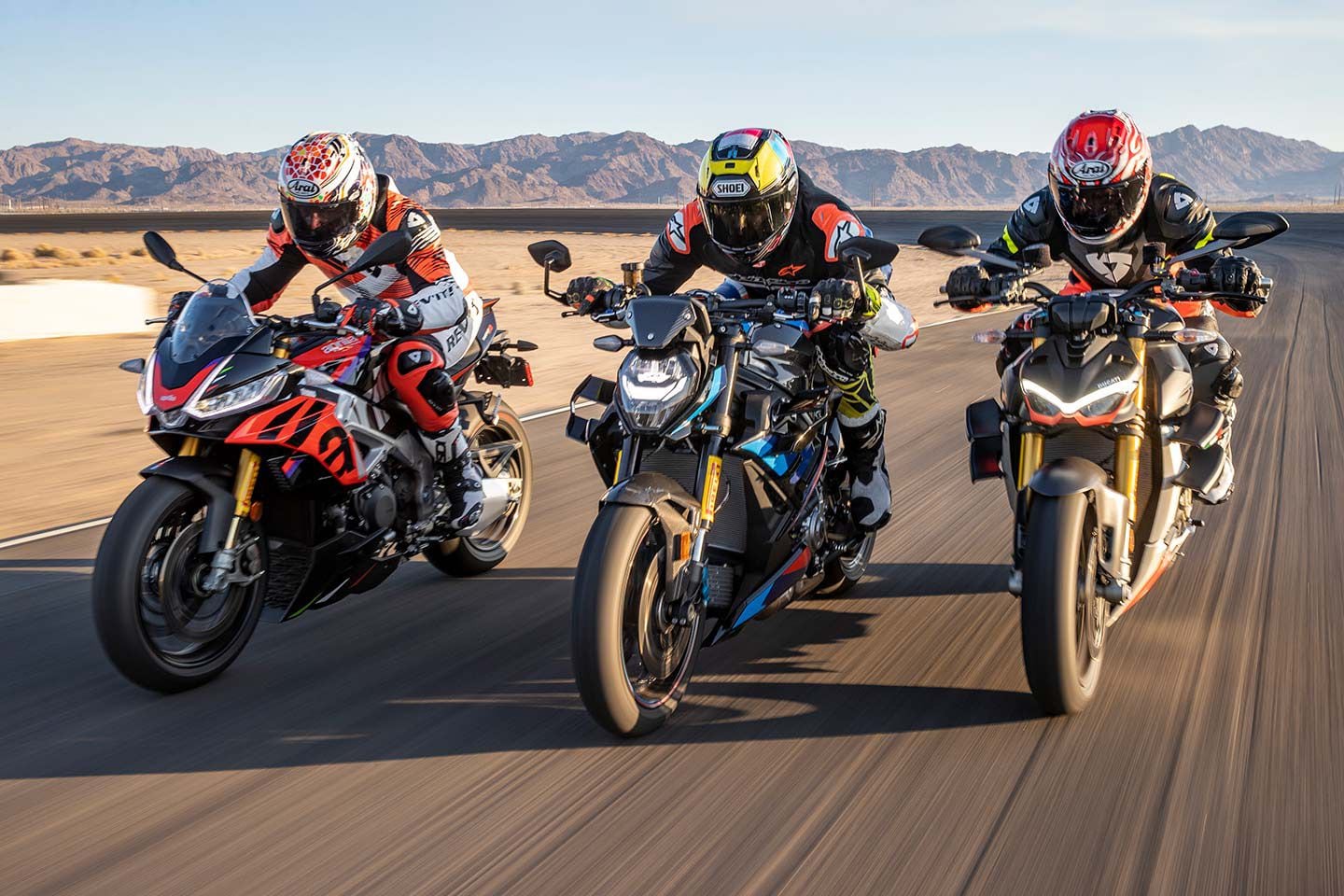 Chuckwalla Valley Raceway east of Palm Springs, California, was the site of our track testing. (Jeff Allen/)What is the most badass production hyper-naked sportbike on the market? Two standouts for 2023 certainly aim to fit the bill: the $27,640 BMW M 1000 R and $37,995 Ducati Streetfighter V4 SP2. These machines have the highest claimed stock horsepower in the hyper-naked class along with MotoGP-derived winglets and high-end suspension, so putting them head-to-head was a no-brainer. But they aren’t the only bikes in the class, so we conducted a two-part shootout to determine who would step into the ring with this duo and see if they are as good in practice as on paper. In the first part of our bracket-style competition—which included machines in the $20,000 price range—the very balanced performing and multitime Ten Best–winning Aprilia Tuono V4 Factory 1100 beat out KTM’s 1290 Super Duke R Evo and Yamaha’s MT-10 SP for the honor of going up against the more expensive BMW and Ducati. 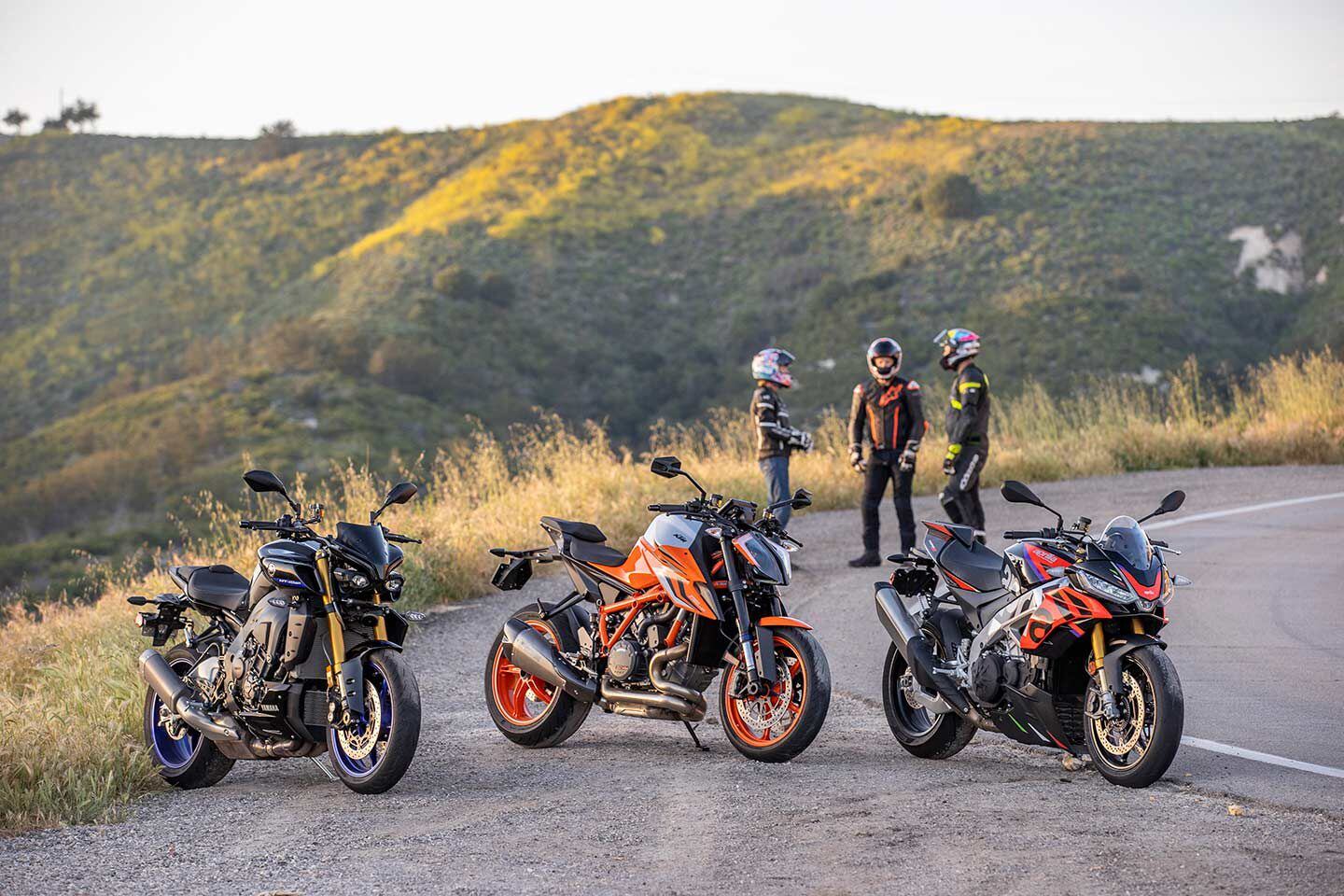 Part 1 of our two-part test included the Yamaha MT-10 SP, KTM 1290 Super Duke R Evo, and Aprilia Tuono V4 Factory 1100. (Jeff Allen/)To push the three finalists to the maximum, we spent an entire day lapping in 100-plus-degree heat at Chuckwalla Valley Raceway just east of Palm Springs, California, then two full days on the street riding the bikes back-to-back in the Santa Monica Mountains in Malibu. To keep all three machines on an even playing field each was fitted with Pirelli’s latest Diablo Supercorsa SP - V4 tires. Engines V-4s are dominating in MotoGP and World Superbike. These three naked bikes give insight into how a V-4 compares straight up against an inline-four. The Tuono’s 1,077cc 65-degree V-4 traces its roots back to 2009?s Aprilia RSV4 Factory, while Ducati’s 1,103cc 90-degree V-4 Desmosedici Stradale engine is much younger, first appearing in the Panigale V4 for 2018. BMW shocked the world with an inline-four S 1000 RR back in 2008, but it wasn’t until six years later that the naked S 1000 R was brought to market. 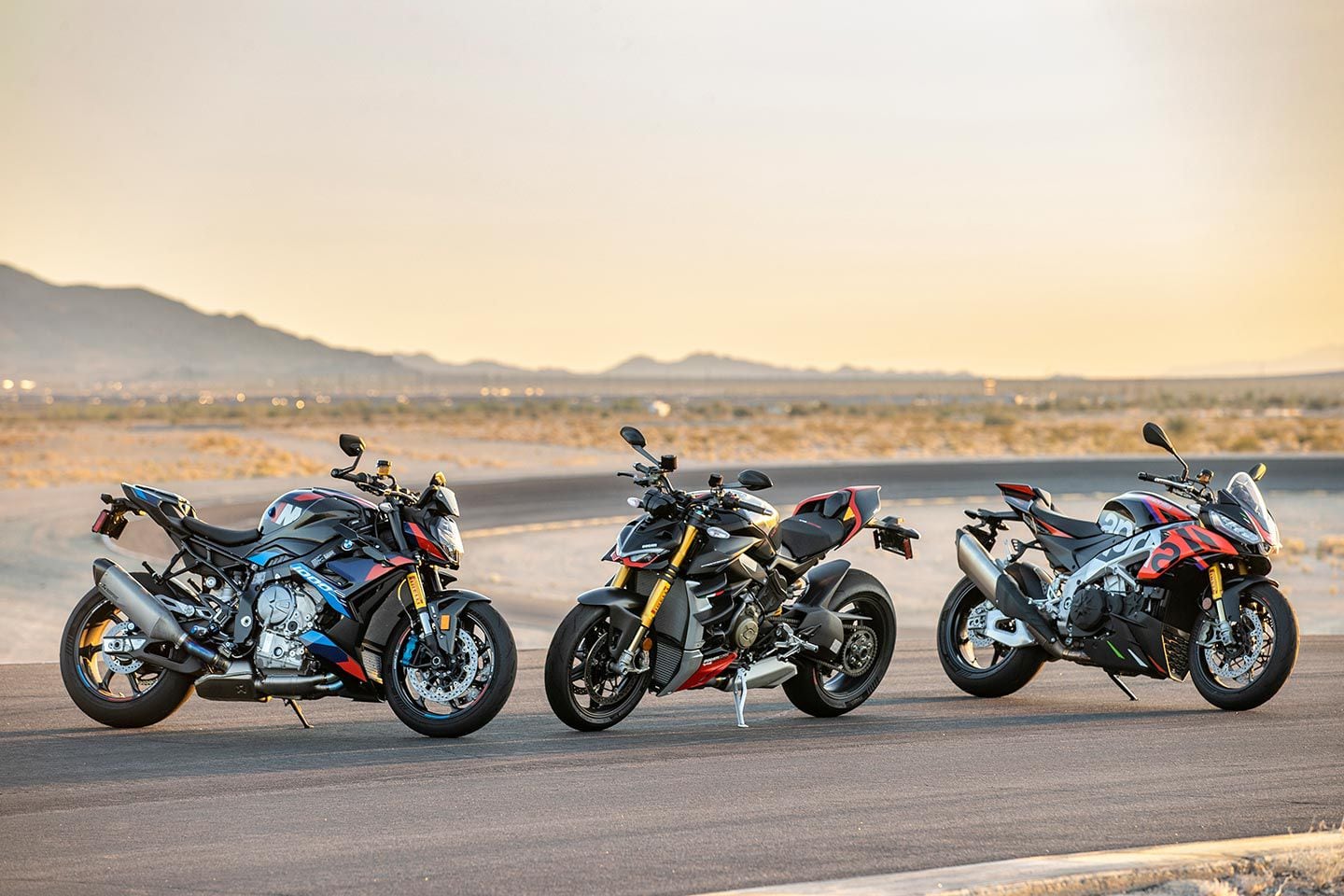 Two of our players use V-4 engines, while the BMW uses an inline-four. (Jeff Allen/)All three of these machines are plucked from multi-model-family lineups. The Aprilia has a sibling in the form of the $16,199 Tuono V4 1100, which is slightly more sport-touring oriented with a less aggressive riding position compared to the Factory in this test. Ducati’s Streetfighter V4 SP2 is the top-tier version in the three-bike V-4 line (unless you count the $68K limited-edition Lamborghini version). And BMW’s M 1000 R also has to share a room with the not-quite-so-well endowed $14,990 S 1000 R that makes considerably less horsepower. 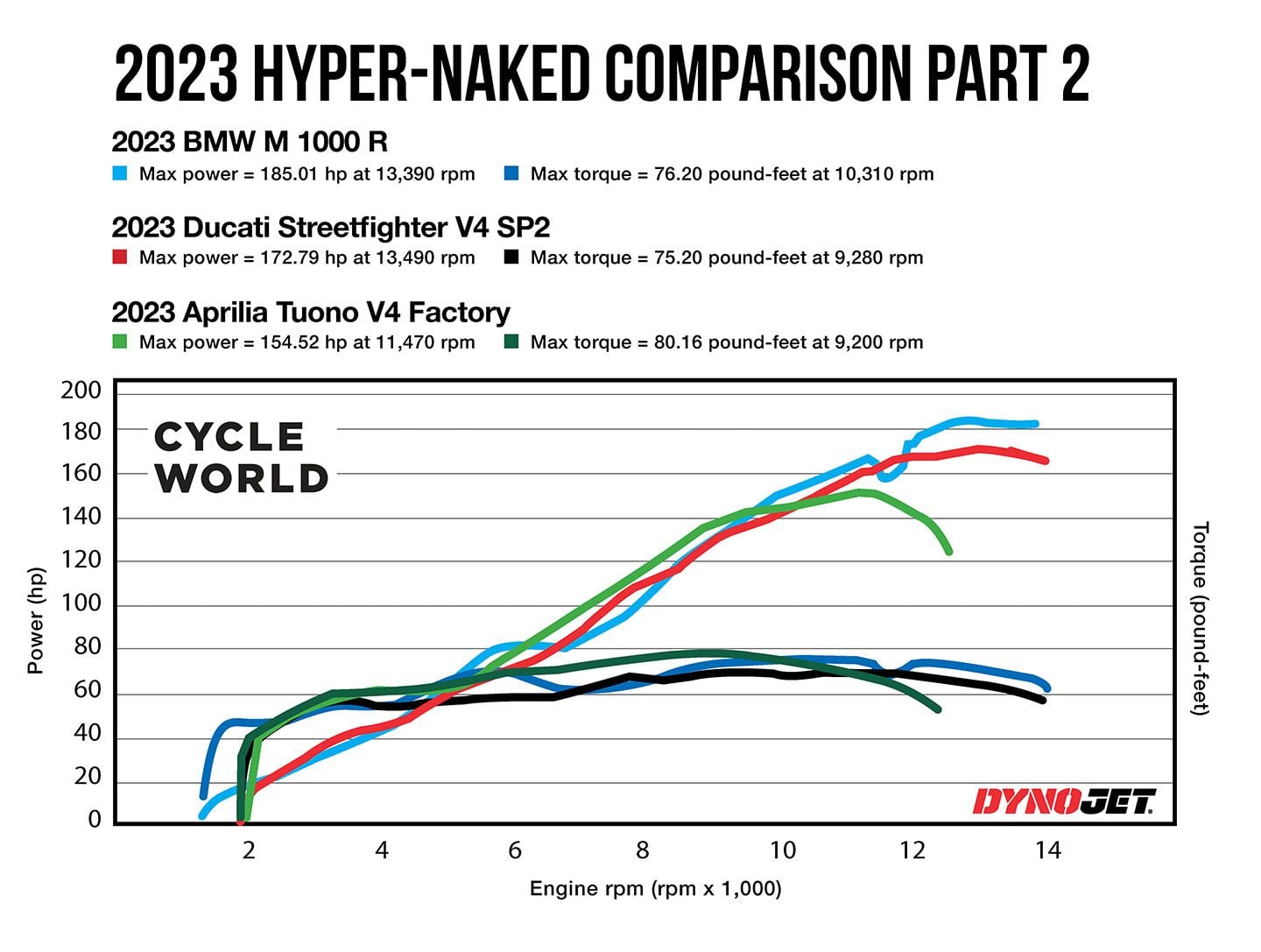 The overlaid dyno graphs show the contrast between the three contenders. (Dynojet/)Before the street and track we found out how the rear-wheel horsepower stacked up on the Cycle World Dynojet dyno. Aprilia’s V-4 produced a solid 154 hp pull at 11,500 rpm with 80.2 lb.-ft. of peak torque at 9,200 rpm. While the curves look really nice, there is a little dip between 5,000 and 6,000 rpm. Ducati’s SP2 (identical to all the engines in the Streetfighter V4 lineup in terms of performance) generated 173 hp at 13,500 rpm and 75 lb.-ft. of peak torque at 9,300 rpm. Like the Aprilia, the SP2 lays down a bit between 4,000 and 6,000 rpm and then is linear to redline. But the real difference is that the Desmosedici Stradale just keeps on pulling up top, blowing the Tuono into the gravel trap. On the dyno charts, the BMW’s power and torque curves are a bit messy. The M makes 185 hp at 13,400 rpm and 76.2 lb.-ft. at 10,300 rpm, but those curves look like a supercross whoop section with dips and spikes all over the place, especially through the midrange where the two V-4s are more linear. Sound emissions requirements demanded electronic intervention. 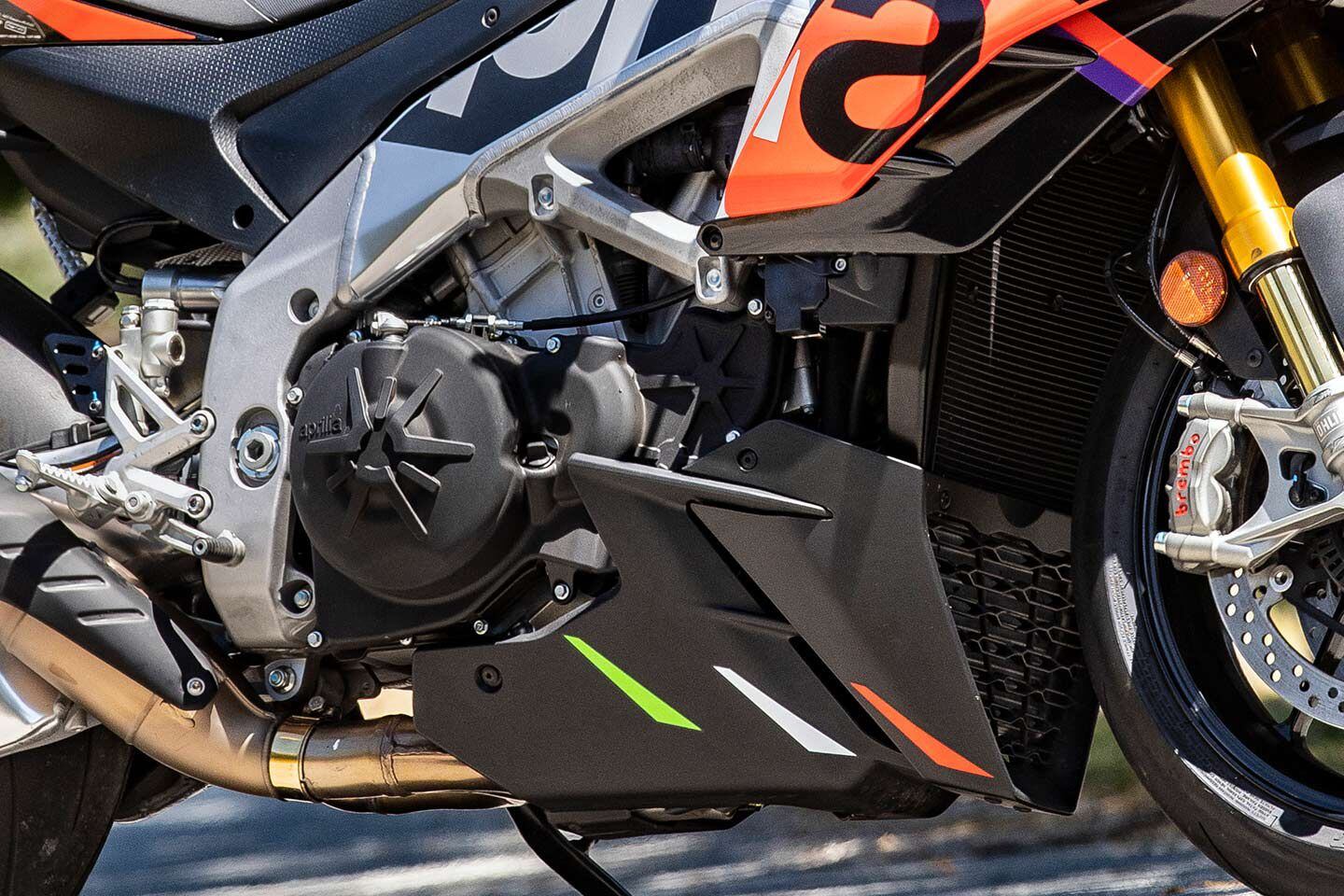 Aprilia’s 1,077cc 65-degree V-4. (Jeff Allen/)“It only takes a few corners behind the Streetfighter V4 or M 1000 R to realize that the Aprilia is missing something getting off the corner,” In-Market-Editor Bradley Adams said. A deeper dive reveals that the Tuono has taller overall gearing, which means that you aren’t always in the ideal part of the rev range and stuck between gears, so to speak. “Yes, this is still an incredibly potent engine that’s plenty fast for spirited track riding, but less snap off the corners and a sizable top-end horsepower deficit means it’s tough to keep the Ducati and BMW in your sights at either end of a straightaway,” Adams added. 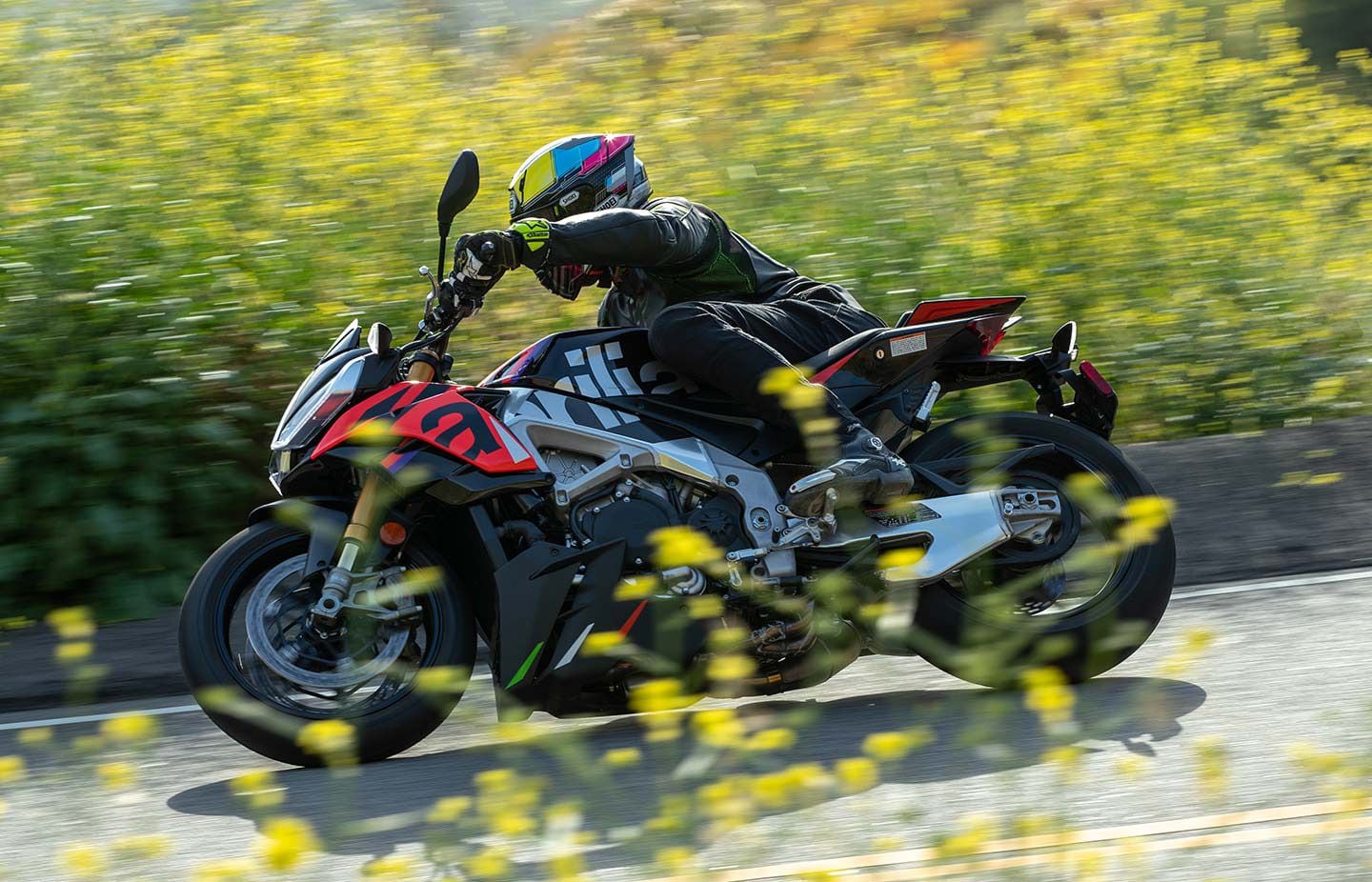 On the street, the Aprilia’s taller gearing and a slight dip in the power and torque in the midrange keep it from punching out of corners as well as the Ducati. (Kevin Wing/)On the street, the Tuono’s shortcomings are exaggerated. That slight dip in torque at 5,500 rpm combined with taller gearing and slightly numb throttle feel means the Tuono is less aggressive and eager than the Ducati. The Aprilia likes to carry its speed, performing better in big sweepers more than stop-and-go riding. An 80 lb.-ft. of peak torque figure is nothing to dismiss—it is, in fact, the best of the trio and ultimately helped the bike overcome the gearing disadvantage to record the second-quickest lap time at the end of the day. While the Ducati has an excellent quickshifter that knows if you’re in a track mode or street mode, as well as gear position and throttle opening, the Aprilia’s quickshifter feels dated and much less precise. The system doesn’t like quick gear changes in succession and gets hung up from time to time. Blame the electronics and not the quality of the transmission itself. On the street, the taller gearing also means that you have to give the bike higher revs while slipping the clutch more to get rolling. Not a deal breaker by any means, but this definitely makes the Tuono less friendly in stop-and-go traffic. 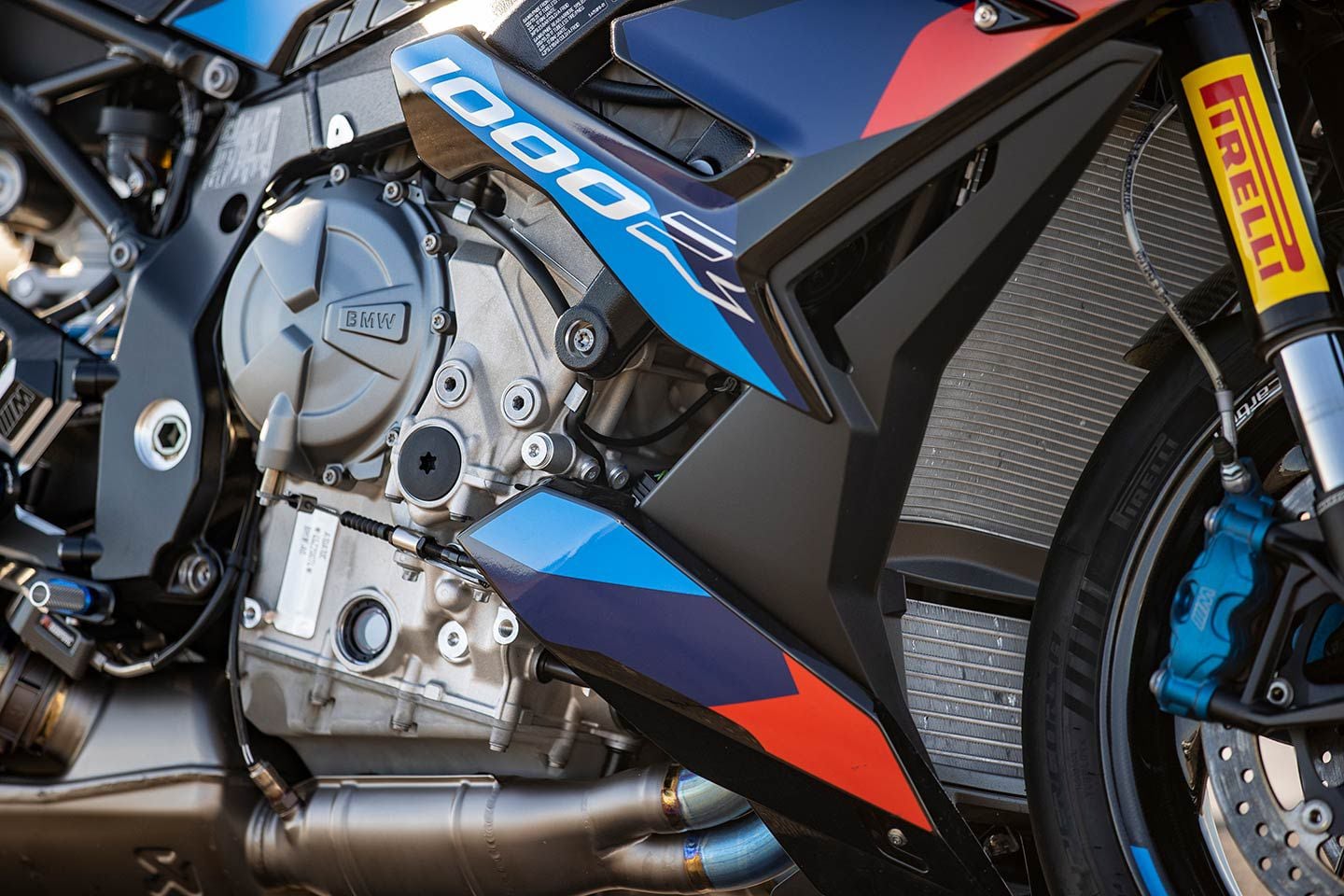 BMW’s M 1000 R utilizes the exact same inline-four engine from the latest S 1000 RR and M 1000 RR. (Jeff Allen/)“BMW’s inline-four impresses on the dyno in terms of peak power, but despite the 185 hp figure it doesn’t translate to real-world performance,” Adams said. “The engine is hindered by electronic mapping that BMW is using to meet emissions standards. The big issue here is a giant flat spot between 6,000 and 8,500 rpm that’s nearly impossible to ignore on the track or the street.” At 7,000 rpm (the bottom of the M’s dip), the Aprilia is making 15 more horsepower and the Ducati almost 10 more. The smooth nature of this inline-four and the familiar and crisp bark of the exhaust note coming from the Ti Akrapovi? pipe are awesome, but the extra work required both on the track and street is disappointing. 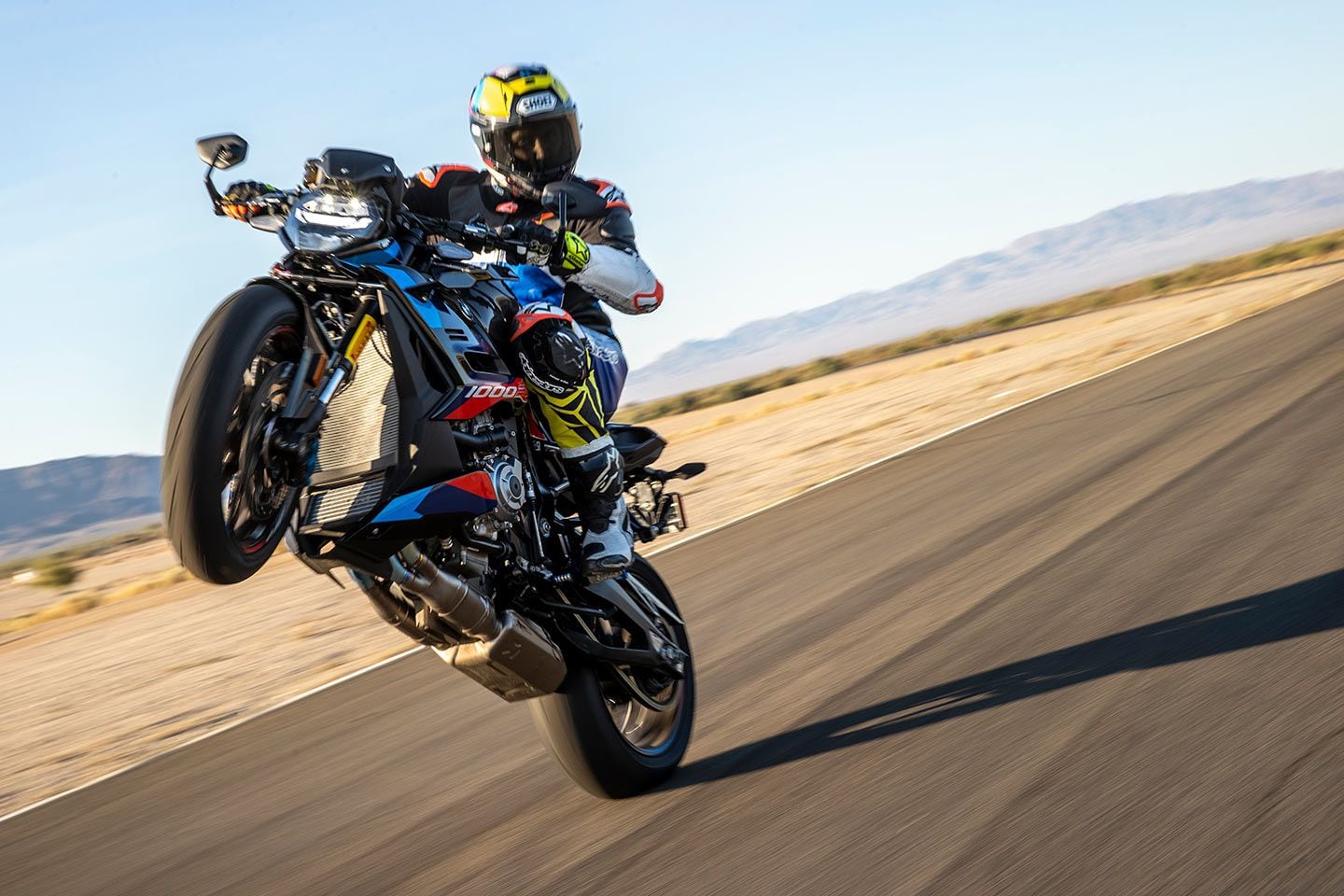 The M 1000 R might have the highest peak horsepower of the trio, but that doesn’t tell the full story about how the engine works in the real world. (Jeff Allen/)“It’s as if you’re riding a different bike depending on what rpm you’re at,” Adams added. “This isn’t limited to track riding either, as even on the street you have to be careful to avoid the flat spot. Oftentimes that means going down to first gear for tight corners, where even on the tall-geared Aprilia you can use second.” As much as you would think that the wide-open confines of a racetrack would let the BMW off its leash, Chuckwalla is still too tight and twisty and lacks a long straightaway—maybe it would be more at home at Road America. Despite the electronic masking, the fueling and throttle delivery are good. Even still, we’d really like to try BMW’s dealer-installed torque-optimization map, or a flashed ECU to see how performance can be improved. 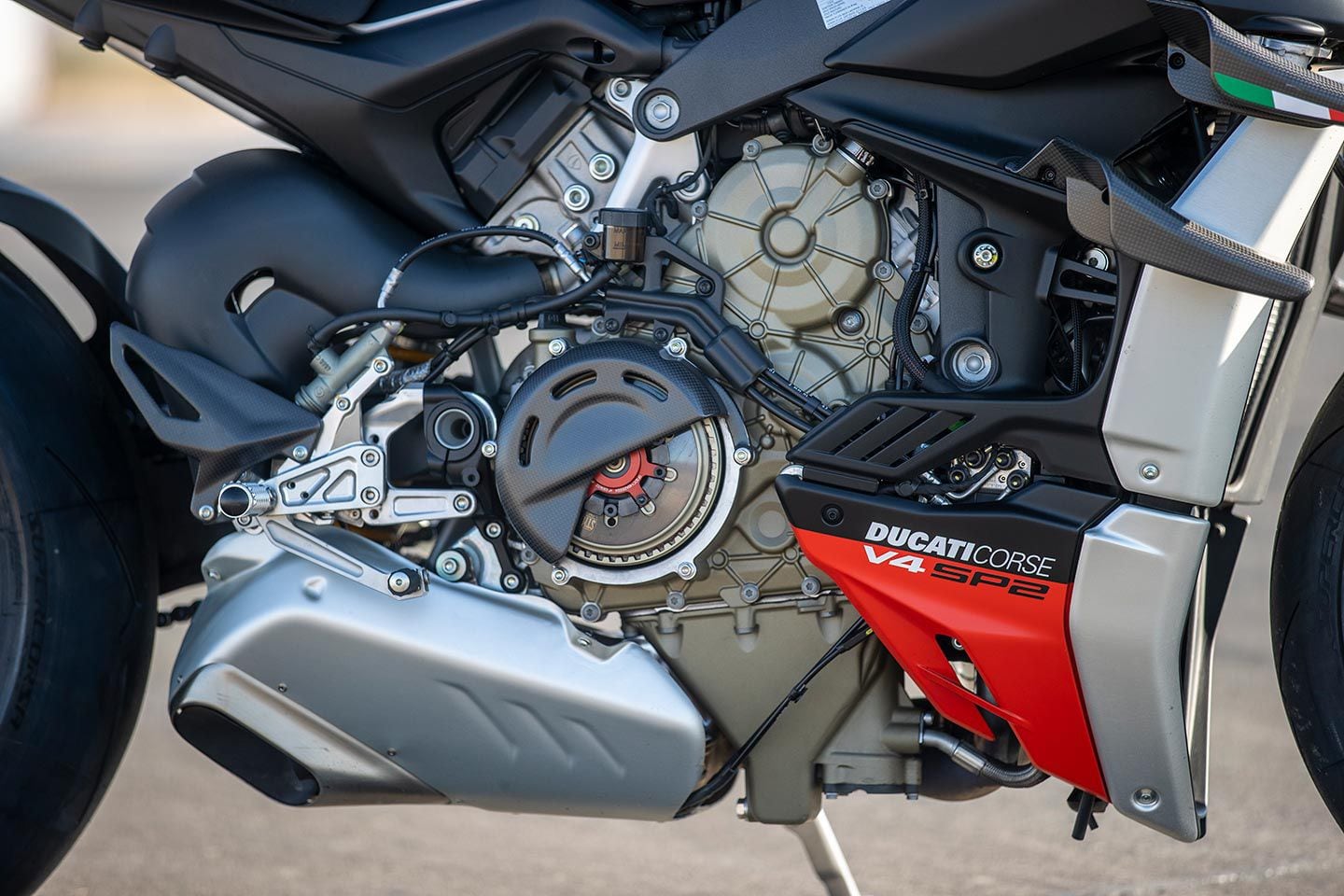 Ducati’s Desmosedici Stradale V-4 can be found in every tier of the Streetfighter lineup. The biggest difference is that our SP2 comes with an STM dry clutch. (Jeff Allen/)“Ducati’s Desmosedici Stradale V-4 has earned a spot in any conversation about the all-time best engines in motorcycling,” an enthused Adams said. “Every other engine we’ve tested, in either part of this two-phase comparison, makes some kind of sacrifice. That’s not the case with Ducati’s V-4 though. It has tons of low-end grunt, pulls hard through the midrange, and is still wickedly strong on top.” If you were to only look at the peak performance numbers, you could easily be bamboozled into believing that the M 1000 R puts a whooping on the Streetfighter. It might not make as much peak power as the BMW, but it’s an extremely flexible engine with power everywhere, allowing you to make fewer shifts per lap, which ultimately makes for a less physically and mentally demanding ride on the track. 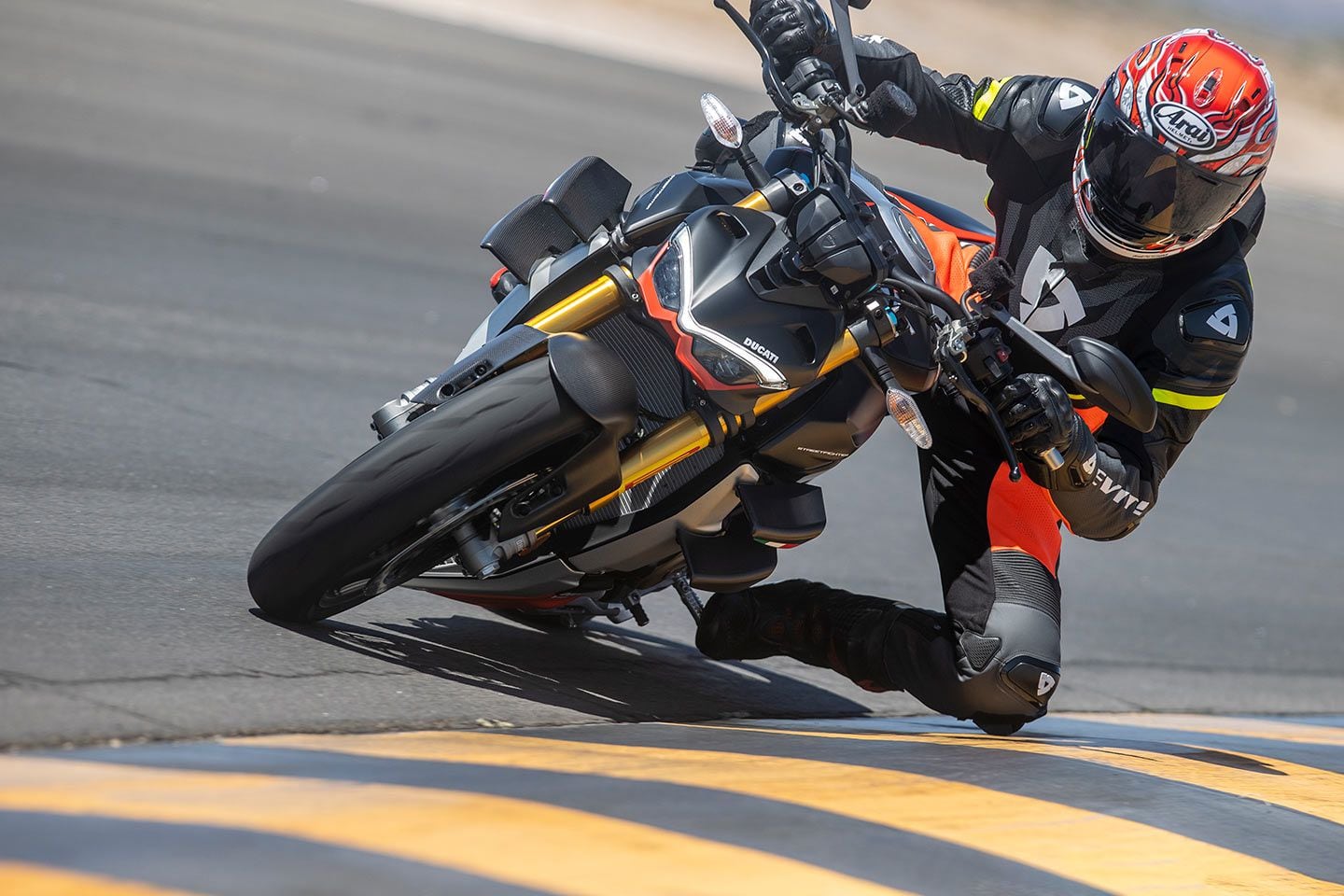 On the track, the Ducati V-4 provides an amazing amount of easily accessible performance. (Jeff Allen/)Lap times are the final word at the track. Despite Adams only getting a single flying timed lap on the Ducati at the end of the day compared to two on the other bikes—we pushed our timing to the end of the day and were bumping up against the track going cold—the Streetfighter slayed the BMW by 2.6 seconds, and the Aprilia by 1.8. We’re confident the damage would have been worse had the checkered flag not been flown early. The brilliance of the SP2 is that as good as the Ducati’s engine is on the track, it’s equally impressive on the street. “On the street, the Ducati has the best response, torque, and makes broad, smooth delivery anywhere in the rpm range,” guest tester Doug Toland said. Second gear, third gear, the SP2 doesn’t care, it just gets down to business. Refined electronics deliver a very direct connection to the SP2?s power. “Using the new Full power mode is the ultimate in terms of responsiveness and takes away the need for a morning coffee,” Adams added. 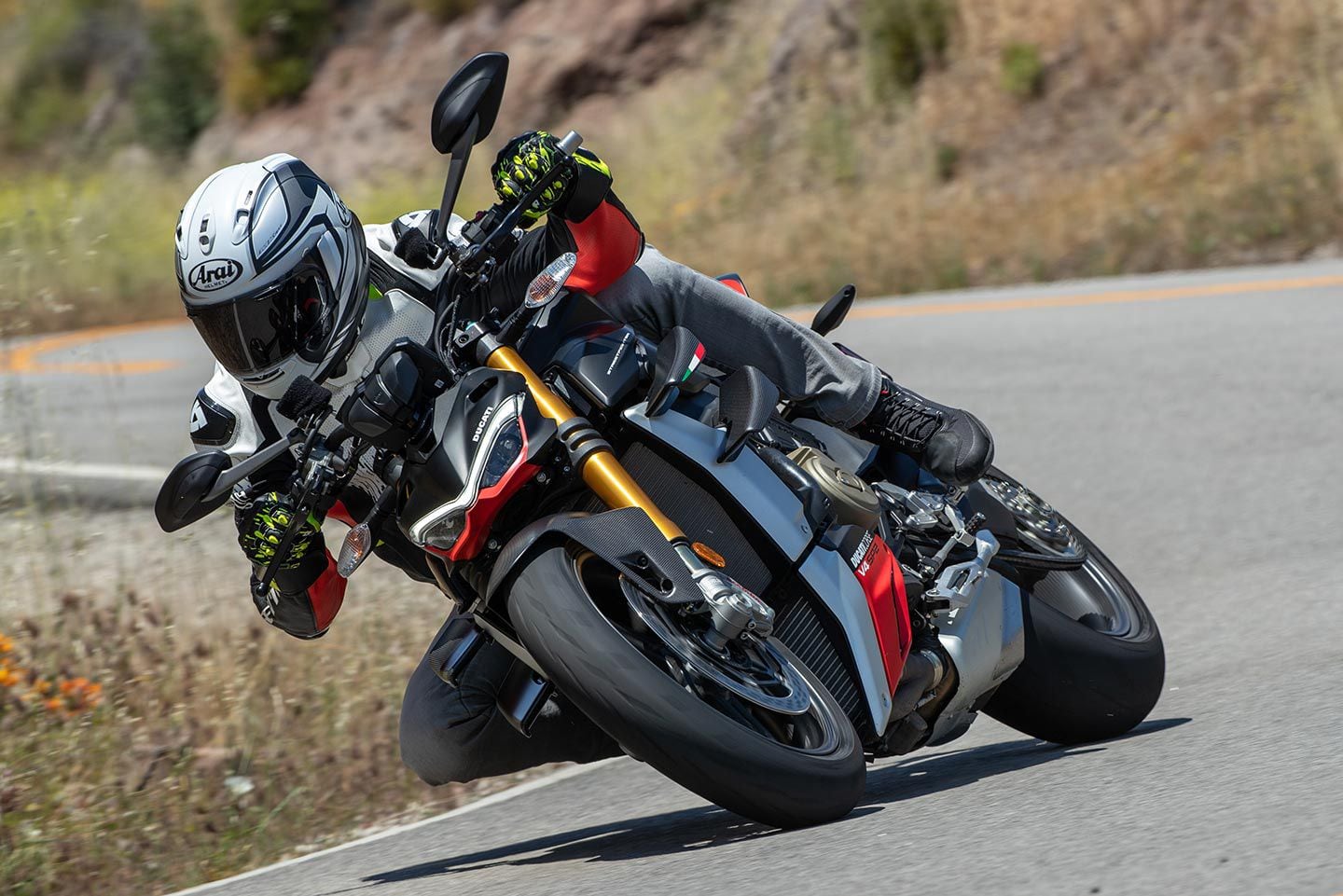 Like on the track, the Ducati is incredibly flexible on the street allowing the rider to work smarter, not harder. (Kevin Wing/)The Ducati’s engine is identical in spec to the other two Streetfighters, save for one significant item, the STM dry clutch. The clutch’s performance was never in question, but, holy crap, it’s loud. Combine that with the already impressive bark from the exhaust and it does make you wonder how BMW is the one getting dinged for sound emissions. Ducati’s rear-cylinder deactivation really helps reduce engine heat to the rider in the cockpit when at idle in neutral. The change in sound and volume when you click it into gear is significant—in a good way. But if you’re trying to sneak out of the neighborhood for an early morning ride, your neighbors may not be happy. Electronics 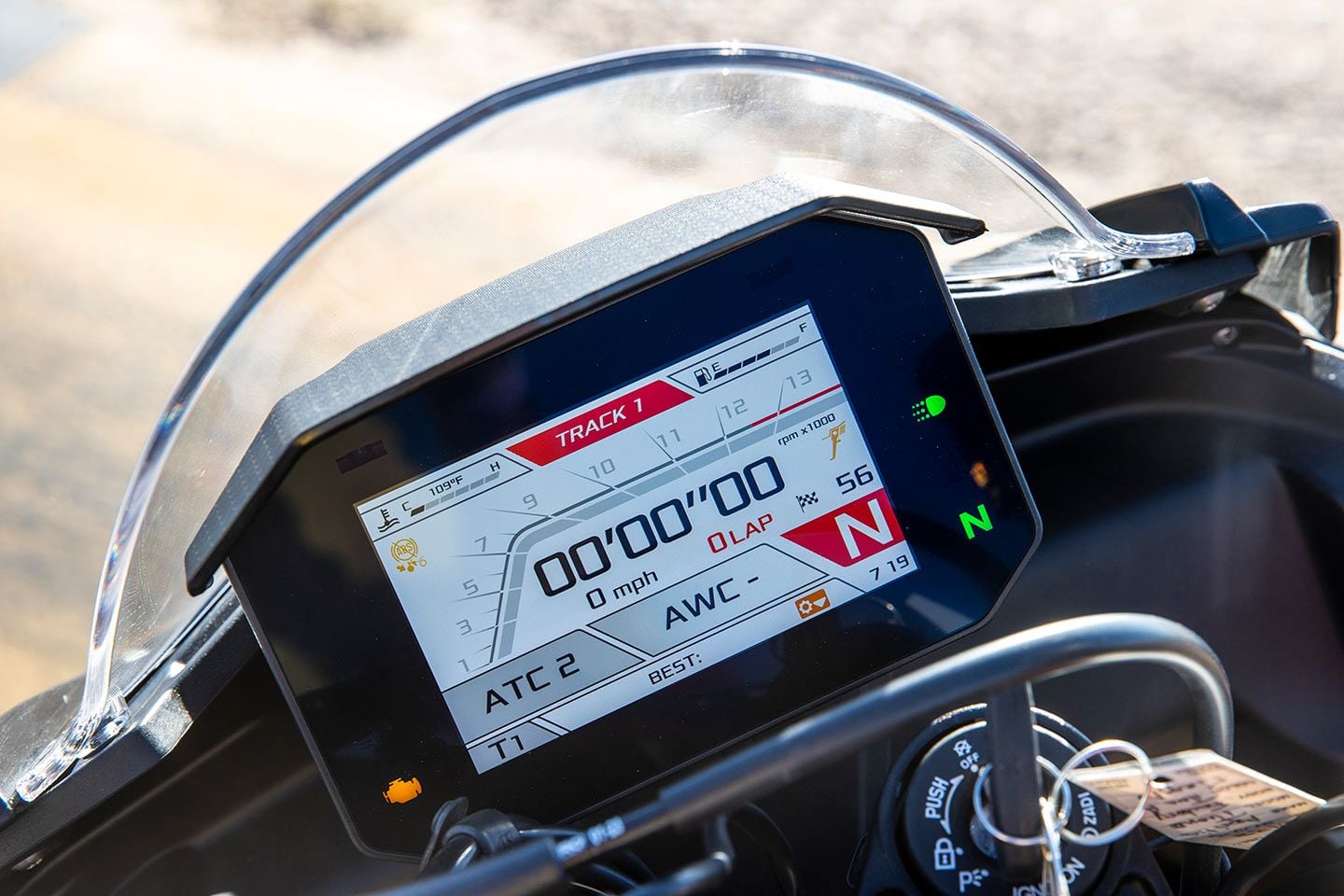 The Aprilia’s suite of rider aids and settings are organized into two categories for road and track, which alters what is displayed and also what you can customize. We really like this strategy. (Jeff Allen/)All three of these hyper-nakeds are pumping out a level of horsepower that really begs for electronic intervention to make them livable on the street and useful on the track. Aprilia’s Performance Ride Control system gives the option to adjust the engine maps (AEM), engine-brake control (AEB), eight levels of traction control (ATC), three levels of wheelie control (AWC), launch control (ALC), speed limiter (APT), and a choice between six ride modes (three road-based modes, three track-based modes). In the Road modes you have a fully customizable User mode, and in the Track modes two out of three can be fully personalized. It also has a six-axis IMU with cornering ABS (three settings), a standard up/down quickshifter, cruise control, and Öhlins Smart EC 2.0 electronically managed suspension. “Aprilia has done an excellent job organizing the electronic rider aids on the Tuono,” Adams said. “Giving the rider just enough options without making them overwhelmed, thanks mostly to the Road and Track screen/ride modes. We liked this feature in the previous test, but it made even more sense here when we tested the bike on track and street back to back.” The Aprilia’s large TFT display is easy to navigate, the right handlebar cluster features a dedicated mode button for on-the-fly changes, and the TC can be adjusted on the fly from the paddles on the left bar when you’re in the Track modes. 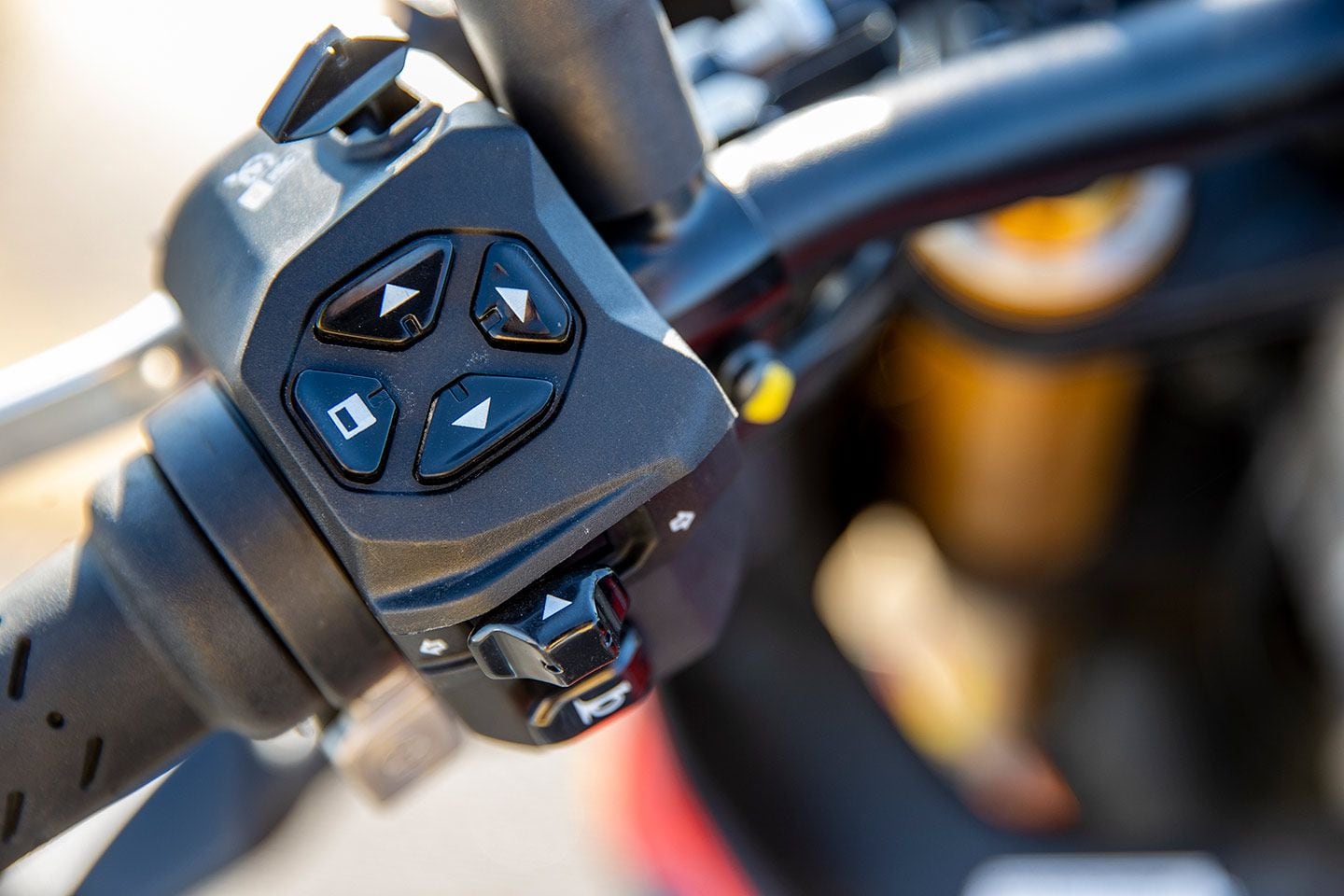 The Tuono’s electronics switch gear takes some practice, but once you get it down it allows for an abundance of logical customization. (Jeff Allen/)Aprilia’s rider aids get the job done, but the intervention is very much in the foreground. You can sense when TC or wheelie control is intervening, and they aren’t as quick as the Ducati at jumping in and taking action. On the positive side, the Tuono’s bar-mounted switch gear and dash navigation is the most intuitive in this trio, making it easy to get into the weeds to make precise adjustments and customize settings. We really like how Aprilia numerically displays the base setting so you always have a reference when you’re making changes. Overall we’ll give the Tuono an A for organization and a B for effectiveness. 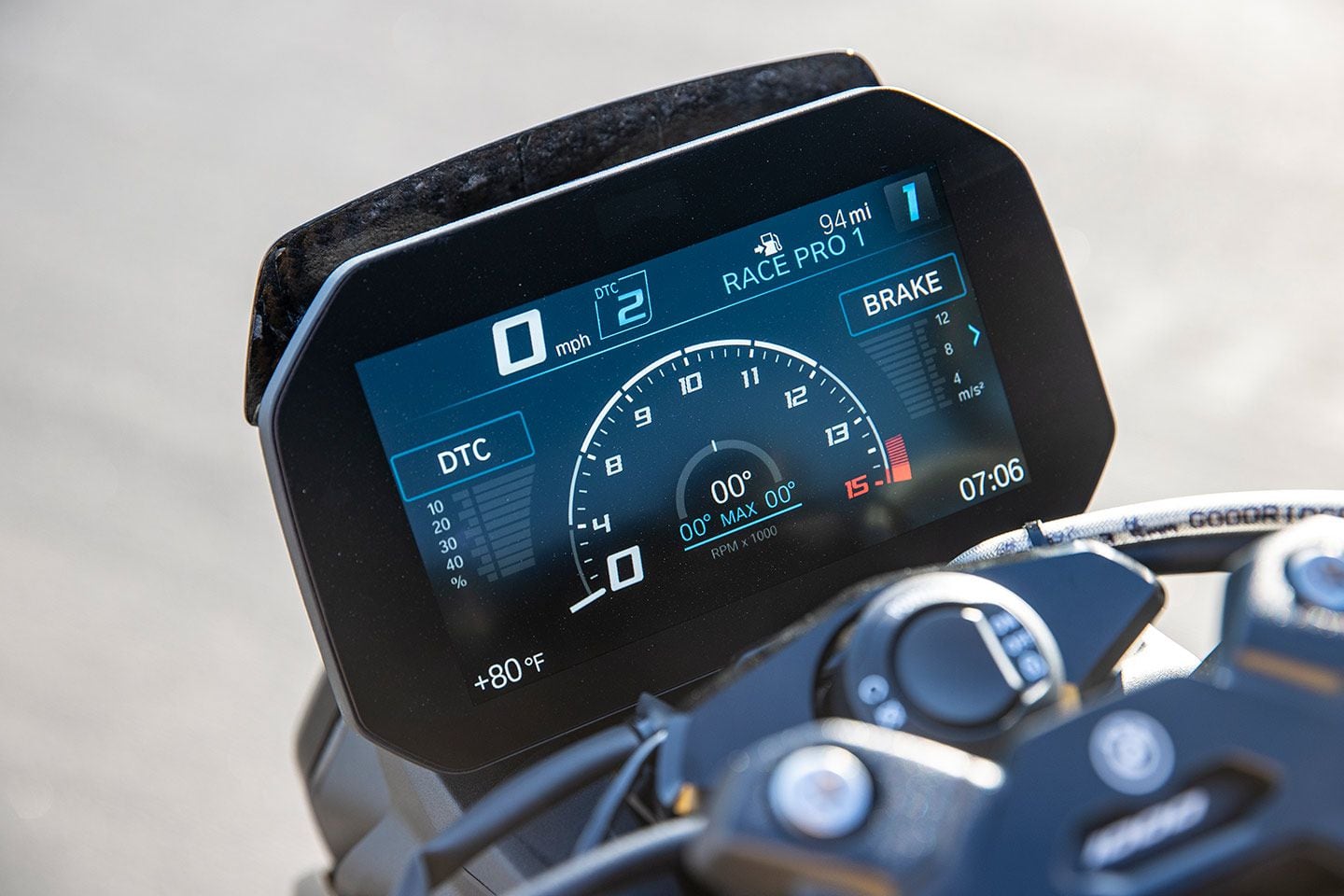 We really like the clean layout of the BMW dash, but wish it displayed more information in terms of rider aids other than DTC, and where they are set. This would give the rider confidence at a glance. (Jeff Allen/)All of the electronic rider aids that are available for this bike come with it as standard. No need to add the Race Pro modes that allow additional control like on the other models. As delivered, the M comes with seven ride modes, including Rain, Road, Dynamic, Race, and Race Pro 1, 2, and 3. Inside the modes are settings for 14 levels of Dynamic Traction Control (DTC), Wheelie Control, Slide Control, Dynamic Brake Control (DBC), shift assistant Pro, Automatic Hill Start Control (HSC), a pit lane speed limiter, Launch Control, BMW Motorrad ABS Pro, electronic Dynamic Damping Control (DDC) suspension, and cruise control. Another nice feature is the keyless ignition that comes with a fob but it’s a pain on the track when wearing leathers. The BMW has a large TFT display that’s clean and simple in appearance and offers multiple display styles, but with all the screen space we wish we could see where other rider-aid settings were set other than just the mode and the TC setting. A dedicated TC button allows you to toggle traction control on or off, however, if you just want to change the preset setting in a particular ride mode, you can only do that in one of the Race Pro modes. 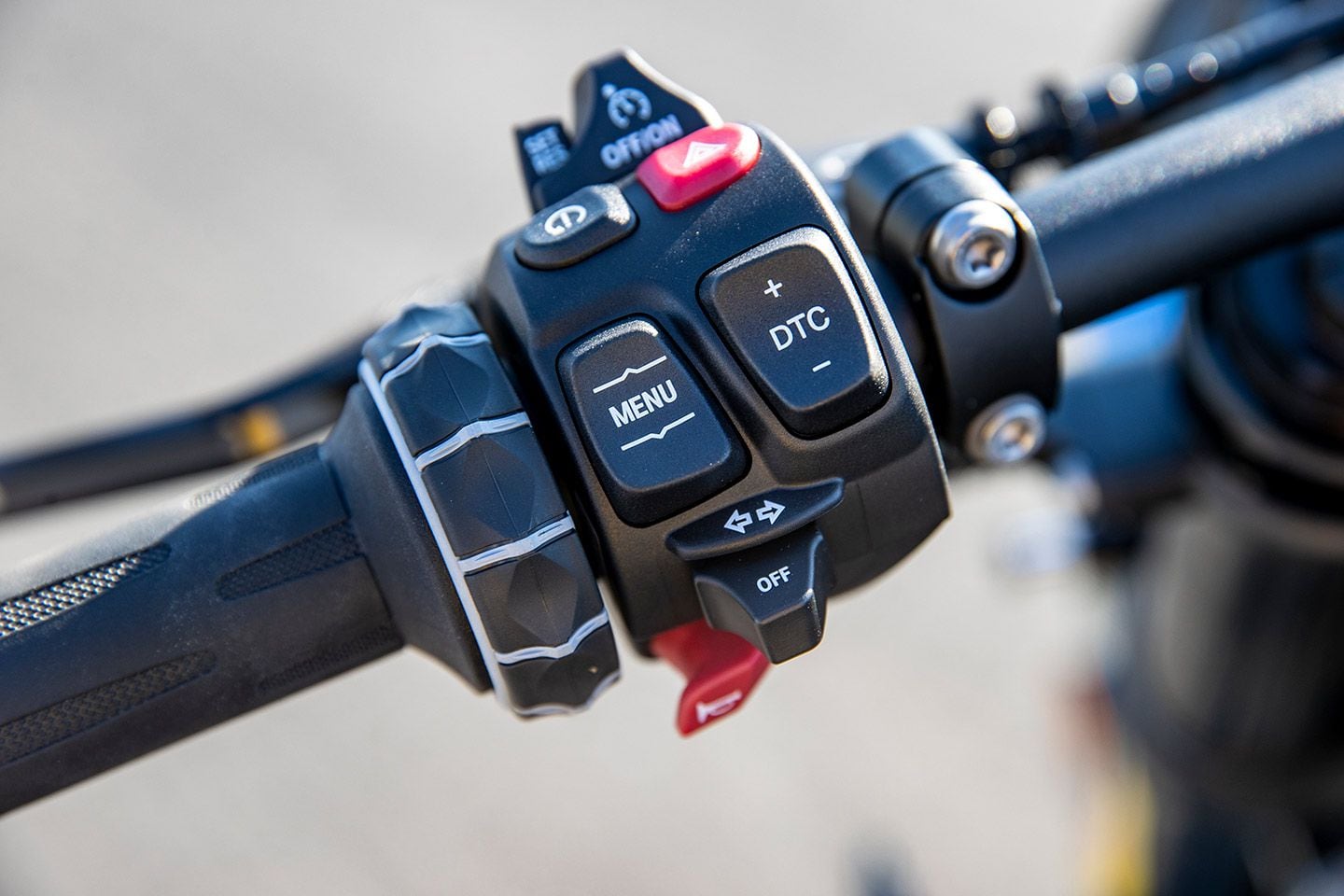 BMW definitely does its own thing when it comes to menu logic. Not everyone likes BMW’s -7 to +7 range for DTC and some other rider aids. (Jeff Allen/)“Why have such an odd range of -7 to +7?” Adams asked of BMW’s numbering system for the traction-control system. “I understand that this technically enables finer adjustment of the systems, but I found it hard to feel a difference between individual levels. And it’s so different from anything else that other manufacturers are using that it’s hard to wrap your head around.” A tighter set of levels like the other two bikes (each offers eight) allows more noticeable differences. The electronics play such a heavy role in your experience with the BMW. Even with all of the rider aids turned off, you still seem to be fighting some form of electronic control. From the way the ride-by-wire throttle doles out power, to how the ECU controls the fuel mapping (with that nasty dip), you are aware of everything the M is doing to meter power, for good or bad. “This is a totally different experience than on the Streetfighter; the Ducati’s electronics feel as though they were designed to work alongside you, to help you go faster. But the BMW’s electronics feel like they were developed to control the ride for you,” Adams said. 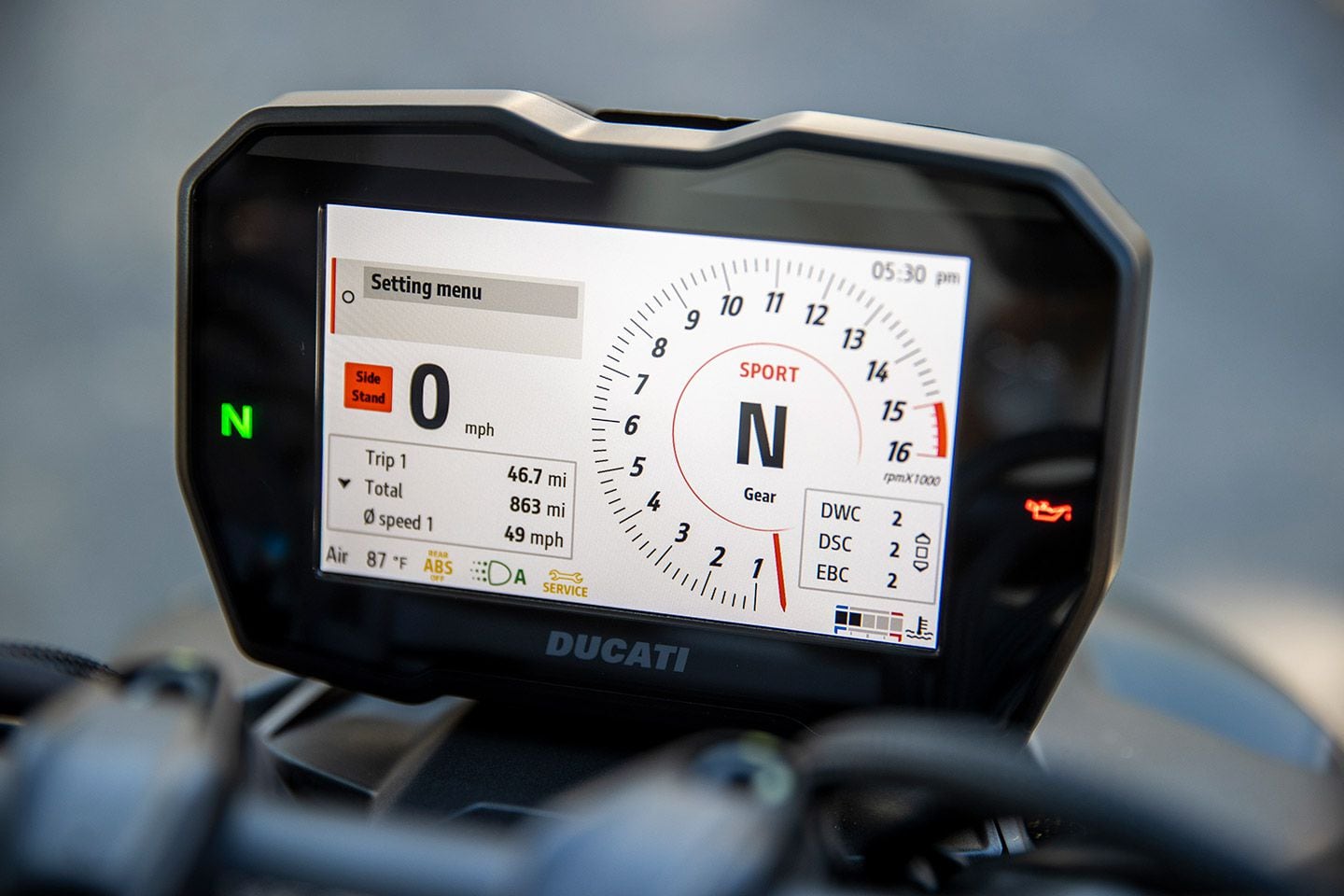 Overall, Ducati has done a good job organizing and displaying its dash, and we really like how you can see where many of your rider aids are set at a glance. (Jeff Allen/)Ducati has a comprehensive suite of electronic aids for the SP2, as well. There are four ride modes including Race, Sport, Road, and Wet. Then you have multiple power modes (Full, High, Medium, and Low) with smooth and dynamic response options. There is a three-level Bosch Cornering ABS Evo, eight-level Ducati Traction Control (DTC) Evo 2, eight-level Ducati Wheelie Control (DWC), two-level Ducati Slide Control (DSC), three-level Engine Brake Control (EBC) Evo 2, Ducati Quick Shift (DQS), Ducati Power Launch (DPL), auto tire calibration, and Öhlins EC 2.0 smart suspension. Ducati is leading the electronic arms race right now. Recent bikes that we’ve ridden like the Multistrada V4 Rally, Diavel V4, and Panigale V4, have one thing in common, and that’s best-in-class electronics. That is 100 percent the case with the Streetfighter V4 SP2. We only wish the Streetfighter had the menu-navigation joystick added to the latest Multistrada because it massively simplifies all the operations required to manipulate the electronics. Also, despite the Streetfighter’s screen being a bit small and densely packed with info, we really like the details it delivers. 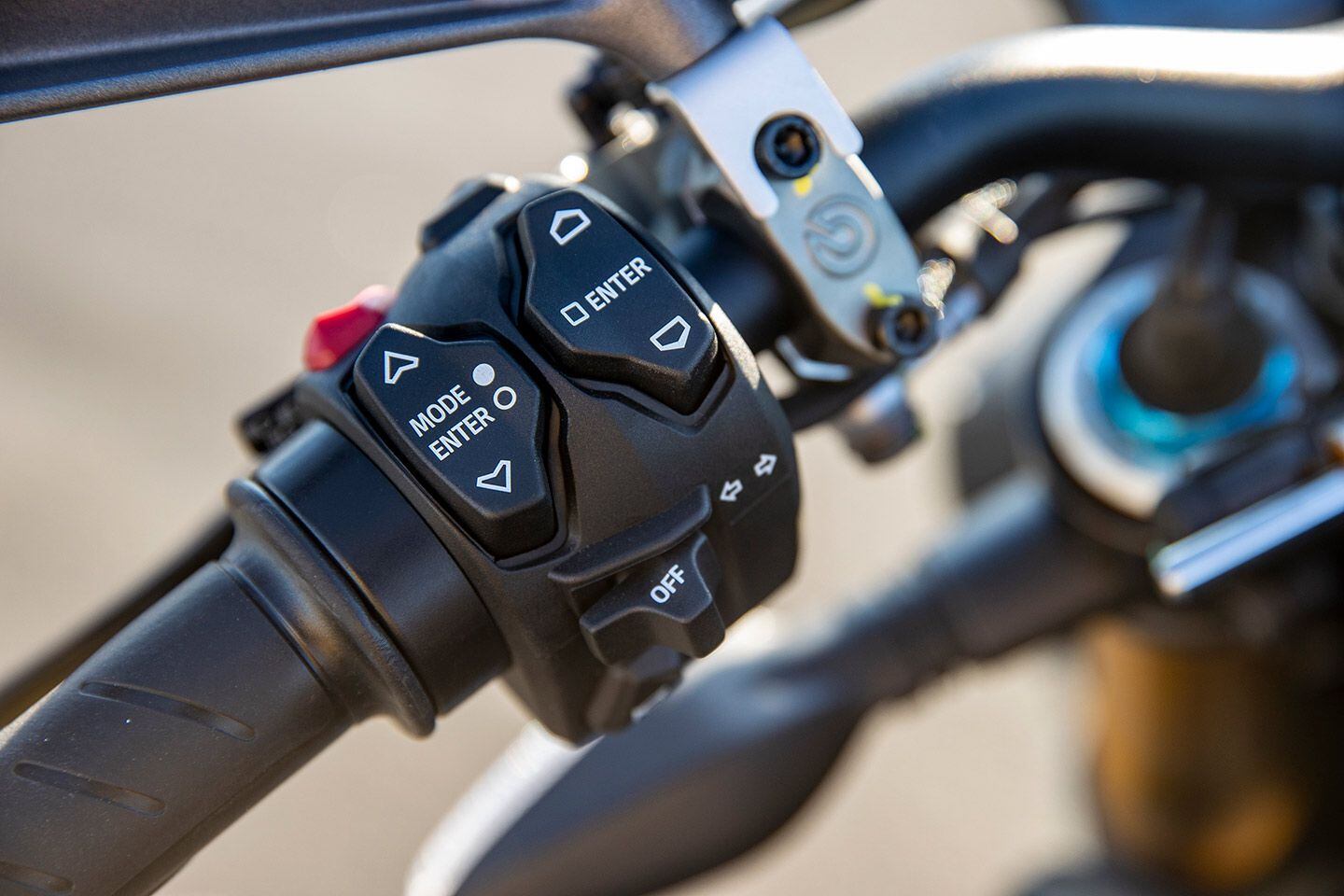 Ducati’s left-bar control pod isn’t as intuitive as on the new Multistrada, but is still logical with some practice. Where is cruise control Ducati? (Jeff Allen/)Here is where Ducati is not only leaving the other two in its dust, but the entire industry at this point: execution. “Electronic intervention is so seamless that you don’t even know the systems are working,” Adams said. “There’s never an aggressive cut when traction control comes on—all you know is that the tires stay in line.” On the track and on the street the only clue that intervention is active is by looking at the respective color-coded boxes on the Track Evo dash and seeing which is lit up. Another feature that Ducati executes best are the green-to-red shift lights, which are at the top of the dash and impossible to miss when at speed on the track. One missing item on the Streetfighter is cruise control. It has everything else, why not include this feature too? 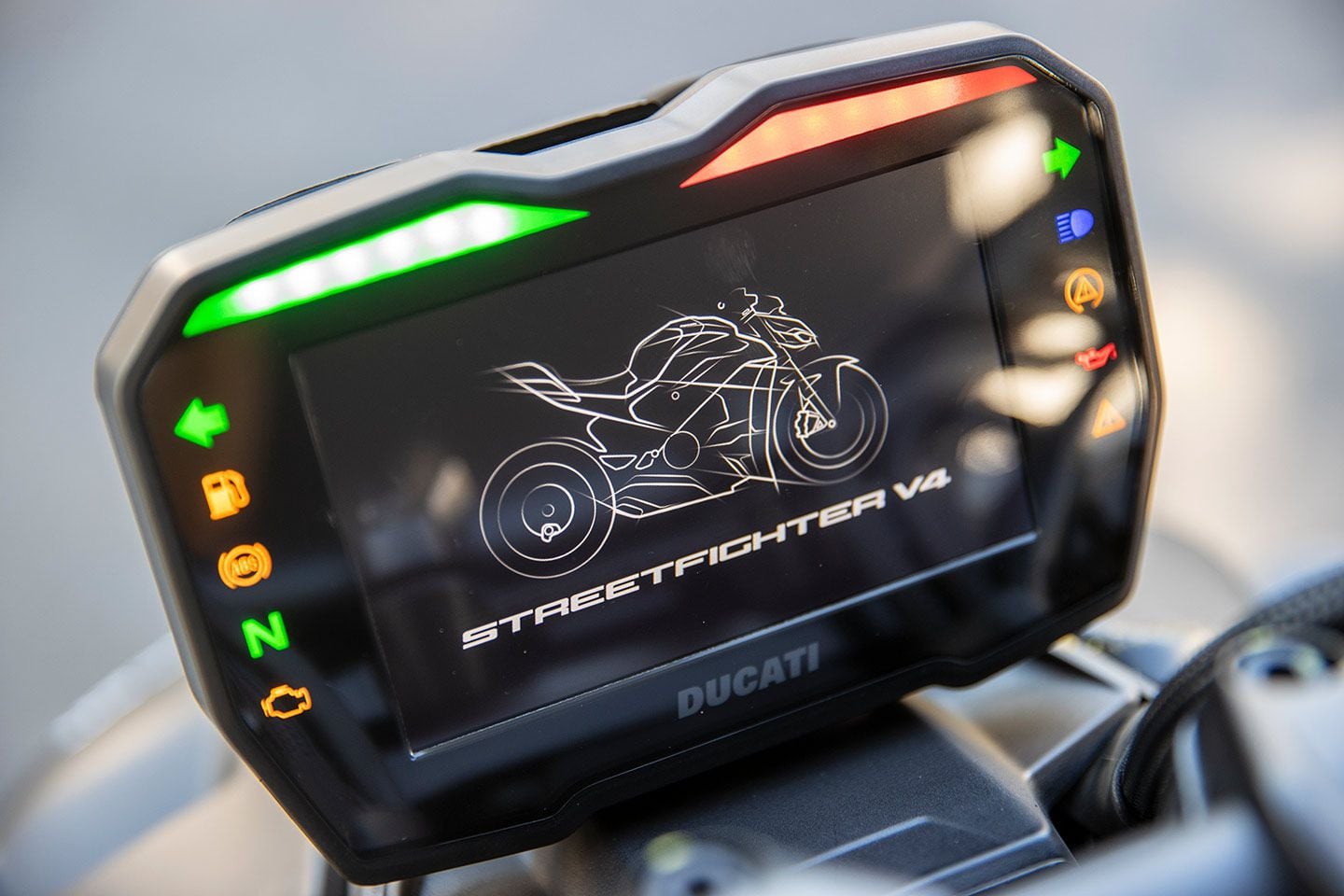 It’s impossible to miss the shift lights at the top of the dash when riding at speed on the track. (Jeff Allen/)Other areas where Ducati is leading the charge are systems like its quickshifter and engine-braking strategy. “The quickshifter is absolutely brilliant, especially with its unique programming for street and track riding,” Adams stated. “It feels like magic, as there’s almost nothing you can do to trick the system. Sure, this high level of refinement is great on the track, but it’s almost as rewarding on the street, because you’re never fighting the shift lever or having to resort to using the clutch lever. The system just works almost regardless of speed, throttle position, or any other input you might actively be putting into the bike.” Like the quickshifter, the engine-braking strategies are gear and throttle-position specific, offering a level of refinement others aren’t matching. Much of this refinement is getting passed down from Ducati’s involvement in World Superbike competition. Those investments, which are vast, are directly making high-performance bikes like the Streetfighter V4 extremely refined and more enjoyable to ride. In the end, that’s what electronic rider aids were created for. The engineers at Borgo Panigale get it. Chassis Both Aprilia and BMW utilize more traditional aluminum-alloy perimeter-style frames, while the Ducati has a similar design to the Panigale V4 with an aluminum “front frame,” using the engine as the anchor for the subframe and other components to bolt to. All three machines provide electronic suspension. The Aprilia and Ducati both have Öhlins hardware (NIX 30 43mm fork, and TTX shock) with EC 2.0 software. BMW uses a 45mm Marzocchi fork and shock of the same make controlled by BMW’s DDC electronic software. 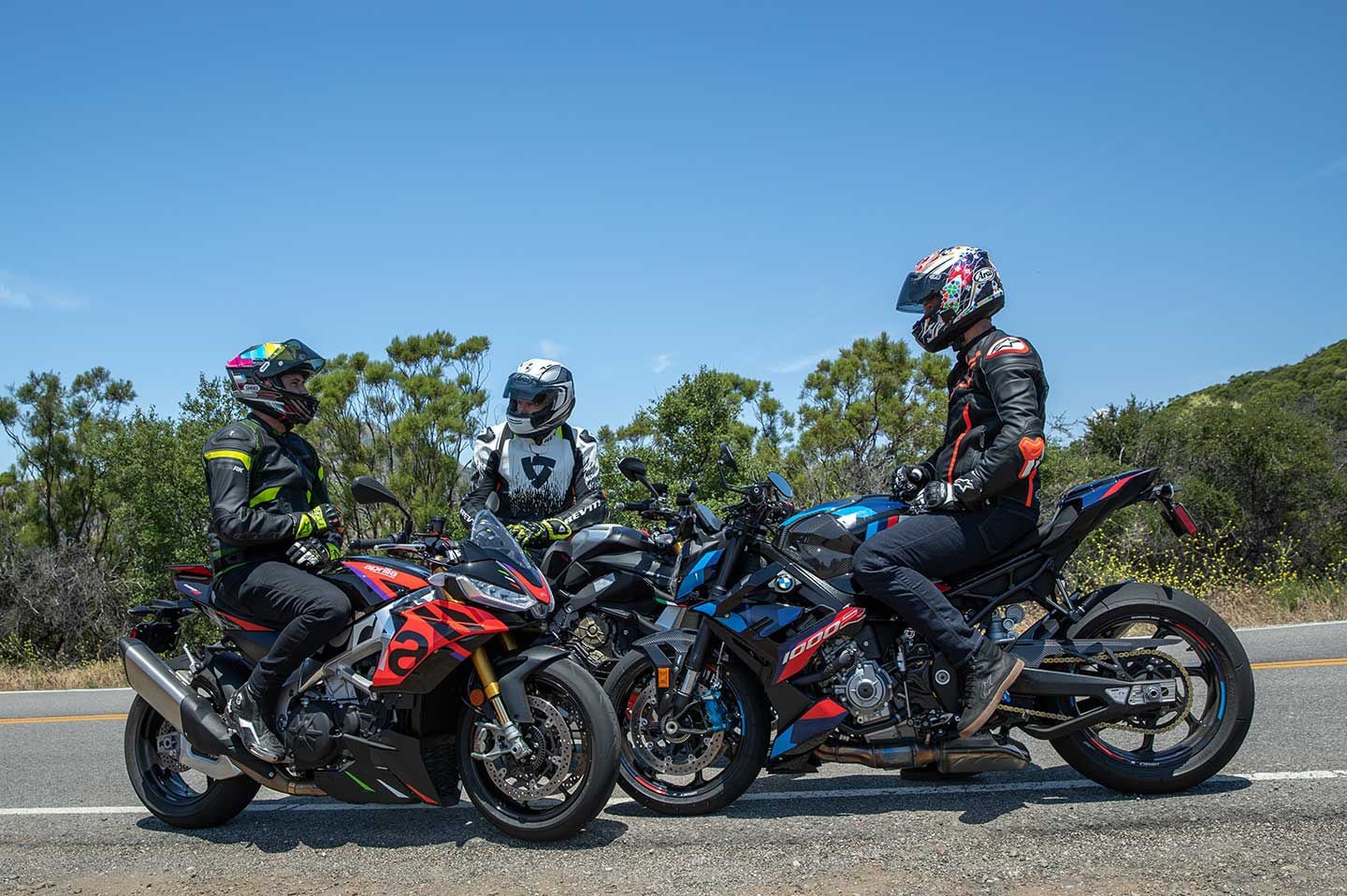 Two of these bikes, the Aprilia and BMW, use traditional perimeter-style frames, while the Ducati uses a “front frame” that depends much more on the engine as a stressed member. (Kevin Wing/)“The beauty of the Tuono’s chassis is how much feedback it has when you’re on the side of the tire,” Adams said. “The feedback from the contact patch gives you the confidence to carry more lean angle and corner speed, and ultimately enables you to muscle the bike around the racetrack at a pace not far off the Ducati.” The Aprilia’s stability comes at the expense of agility, however. Especially on the street, where you get a serious upper-body workout compared to the other two during an afternoon of riding. The Aprilia could benefit from ultralightweight carbon fiber wheels like the other two bikes have. 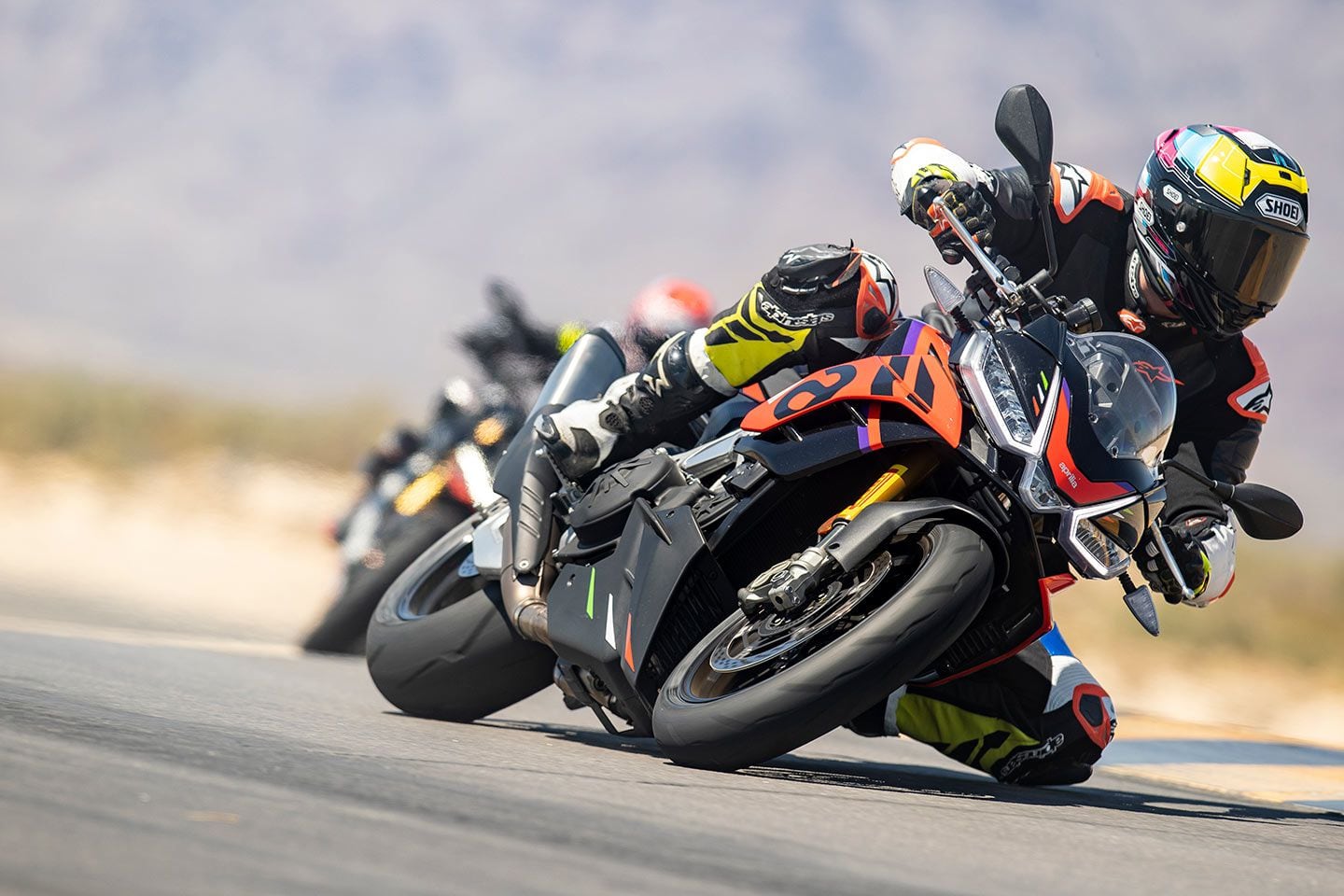 While the Tuono offers amazing midcorner stability, it also isn’t as agile as the other two bikes. (Jeff Allen/)On the track we felt like the Tuono was a bit unbalanced front to rear, which required us to tweak the electronic suspension settings more than on the other two bikes to find the window where it was happy. It’s very easy to go into the dash menus and change settings, and we love how the interface lets you know where the base setting is, so that you don’t get lost while making alterations. As for the street, the Tuono’s midcorner stability is excellent, and its suspension sucks up rough patches that give the other two bikes fits. 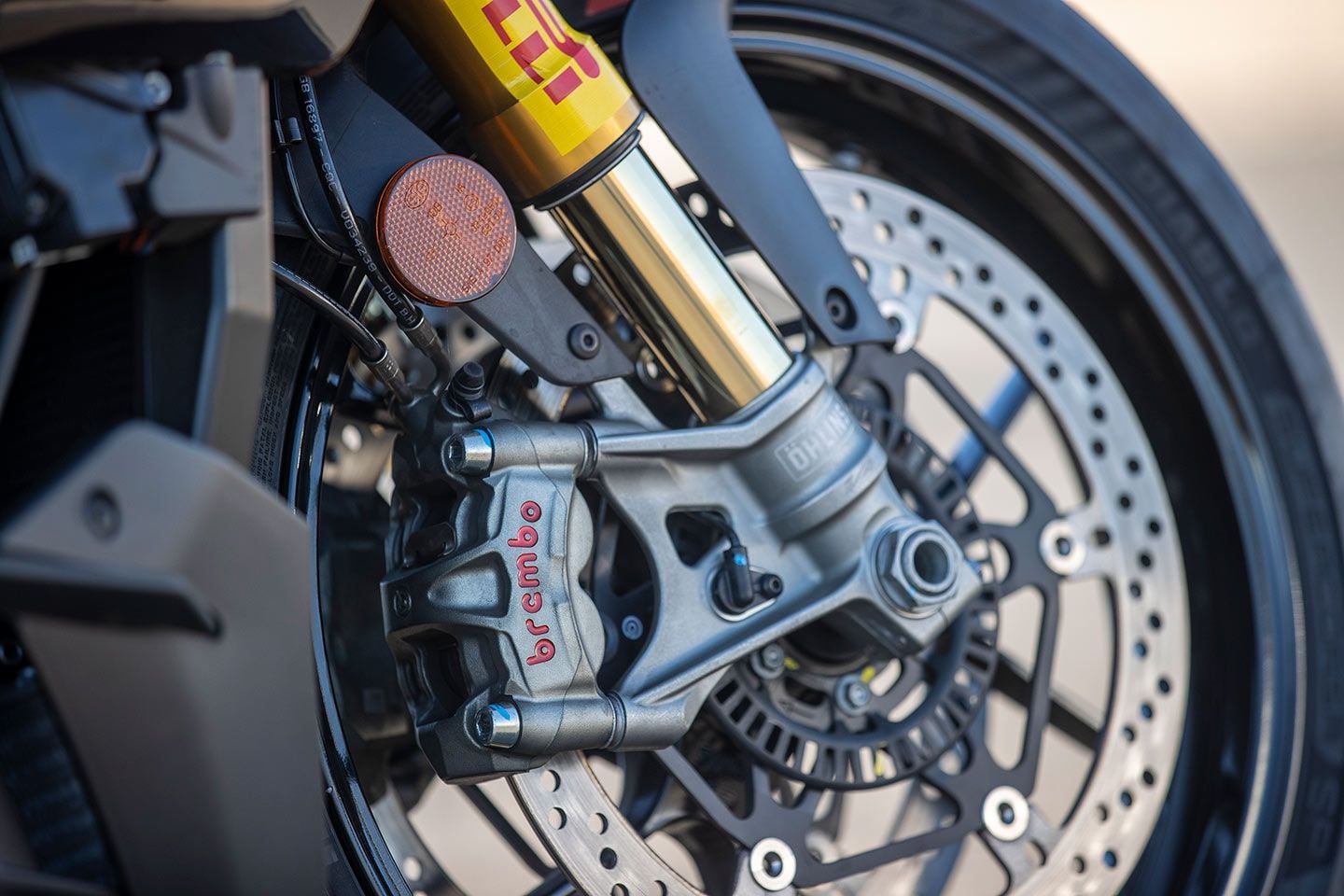 The Tuono uses Öhlins hardware and software for the suspension and Brembo brakes. (Jeff Allen/)Considering the tight setup window, and less agile front-end geometry, the Aprila still has a level of balance between the chassis, engine, and braking that was able to outshine the BMW (in terms of lap time) at the track. The Aprilia’s brakes, when thrown up against the Yamaha MT-10 SP and KTM 1290 Super Duke R Evo, seemed so good, but definitely met their match in this company. The hardware consists of Brembo M50 Monoblock calipers and 330mm discs up front. Don’t get us wrong, these are amazing brakes, but the other two simply outperform them. 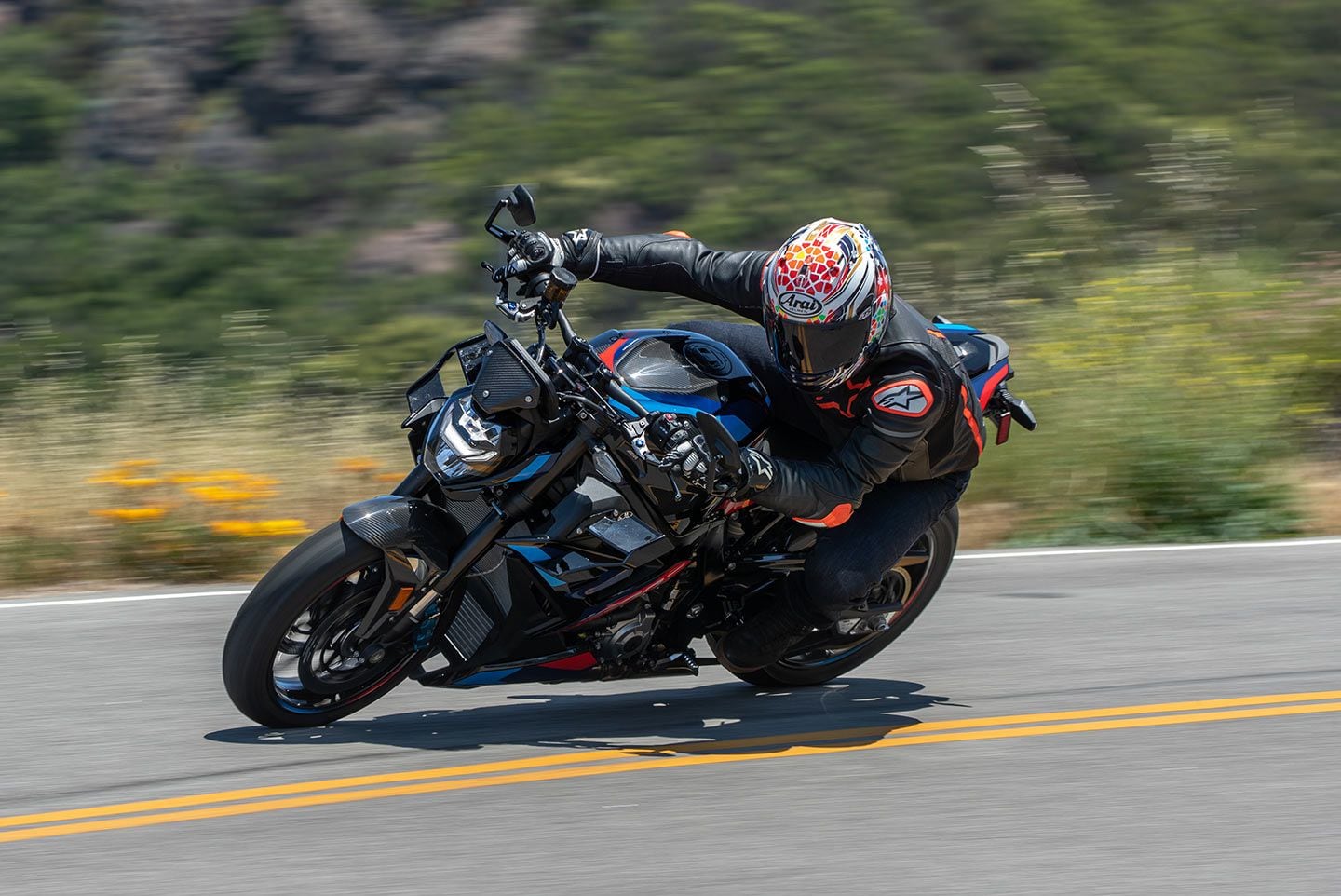 Street or track, the BMW M 1000 R was a favorite in terms of agility and handling. (Kevin Wing/)If there is a bike that got kudos both on the street and on the track in terms of chassis performance, it’s the BMW. We all loved hopping onto the M when we were in Malibu and rotating from bike to bike, and the same can be said on the track. “The BMW is by far the lightest steering, requiring the least effort for directional changes of the three,” Toland said. “However, the trade-off is stability when things get in the upper rpm range. The BMW’s power hits so hard up top on the street that it’s almost like you need a different suspension setting to handle it, because it loads the chassis very differently.” “The M 1000 R is the easiest bike to rush into a corner on, as it’s more composed under load than the Streetfighter, but steers much lighter than the Aprilia,” Adams commented. “And it’s the easiest bike to make midcorner adjustments on, thanks to the aforementioned composure and increased agility over the Aprilia.” 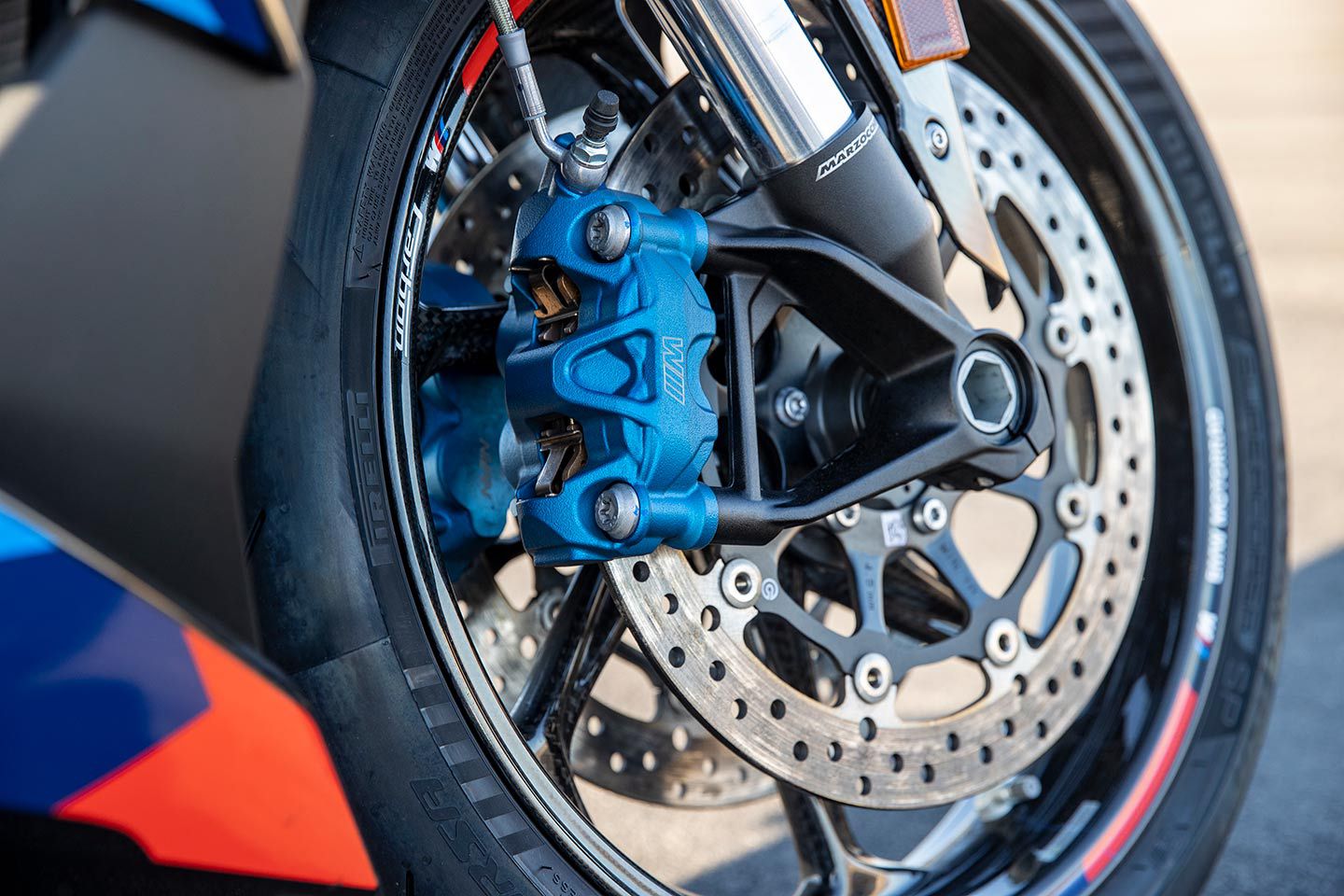 Unlike the other two bikes, the BMW uses Marzocchi suspension and Nissin brakes. Both performed amazingly. (Jeff Allen/)Another benefit to such a good chassis is how well it works in concert with its DDC suspension. “Whereas you have to adjust the Ducati’s electronic suspension quite a bit to help the bike absorb bumps, you almost don’t need to touch the BMW’s default settings for its dynamic suspension,” Adams said. “Such is the benefit of a well-calibrated chassis.” DDC settings for the ride modes are calibrated to the characteristics of that selection, like Rain, Road, Dynamic, or Race. Those parameters can’t be adjusted, but go into the Race Pro modes and you can fine-tune compression and rebound damping settings to your preference with 14 levels of adjustment. Conveniently, BMW has an indicator to show base settings, just as Aprila does. It’s really hard to improve on the level of performance of Brembo’s top-of-the-line braking systems. But the BMW’s blue anodized Nissin radial-mount calipers and 320mm discs match them in every way. They offer a strong initial bite which instantly gives you confidence, and then have excellent stopping power, all the while giving the rider a ton of feedback at the lever. 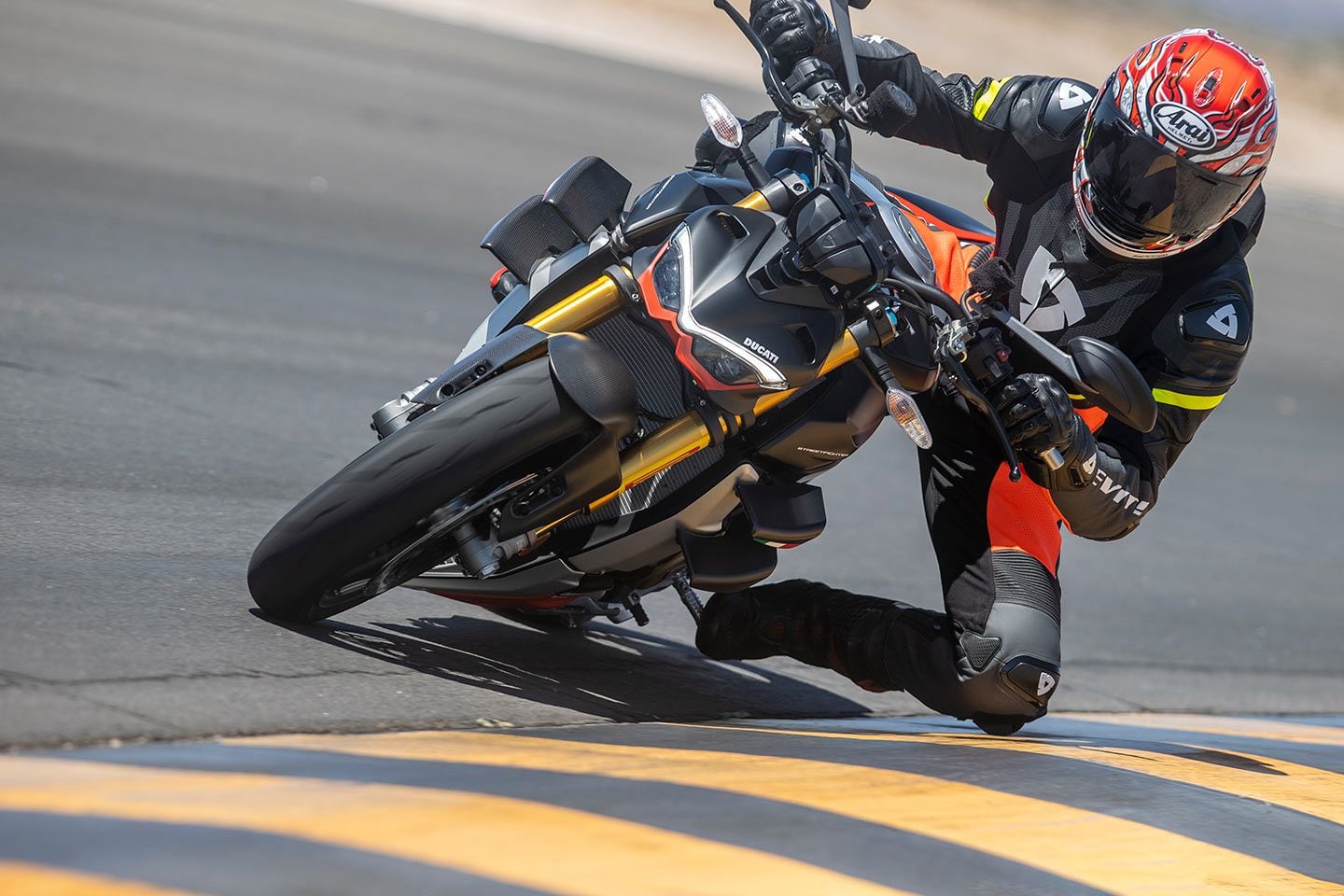 Ducati has gone a different route with its chassis design, and it definitely communicates feedback differently than the other two bikes. It splits the difference between its two competitors here in terms of agility. (Jeff Allen/)“The Streetfighter’s front frame design and its use of the engine as a load-bearing element contributes to a completely different chassis sensation compared to the other bikes in this test, and that takes time to get used to,” Adams said. The chassis is stiff and doesn’t absorb lateral bumps as well as the more traditional twin-spar frames. This is especially noticeable as you’re trail-braking into a corner and increasing side load on the frame; a lack of compliance from the actual frame leads to more front-end movement over imperfect pavement, and gives you less confidence as you tip into the corner. On the other hand, the Streetfighter is very balanced front to rear allowing aggressive input from the rider. Another thing we noticed is how much outright grip the Streetfighter has. “From the second you roll the throttle on, the tires bite into the tarmac and the bike begins driving forward,” Adams said. “There’s no pumping or wallowing.” 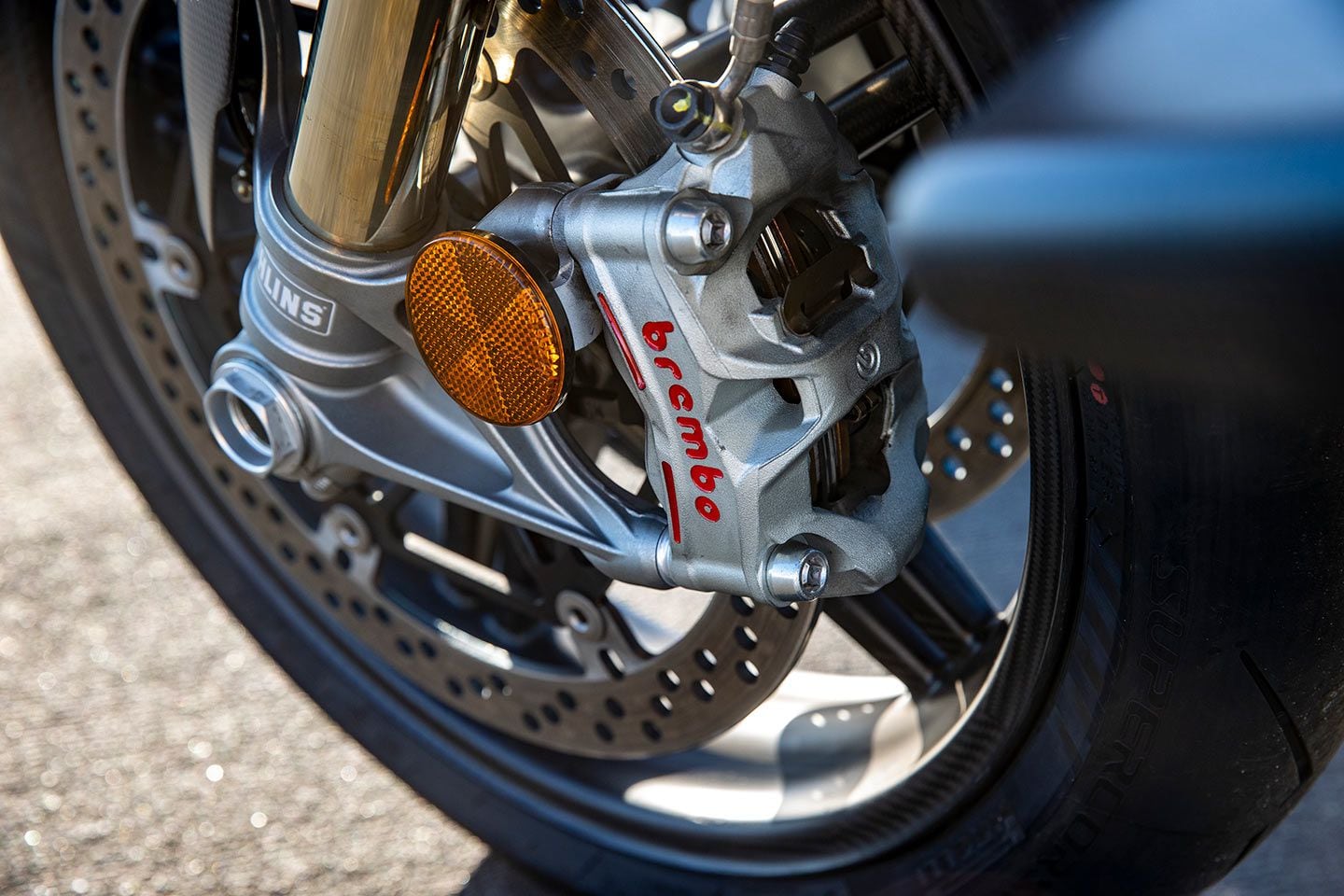 You want exotic? Top-of-the-line Brembo Stylema R brakes, Öhlins electronic suspension, and carbon fiber wheels deliver performance and bling. (Jeff Allen/)The Ducati splits the difference between the other two bikes: It’s not as razor sharp on turn-in as the BMW, but is quicker steering than the comparatively sluggish Aprilia. When you hop between the Tuono and the Ducati there is almost an adjustment period, as the Ducati’s ultra-light carbon-fiber wheels help provide instant steering response. While the chassis feels very rigid and stiff at times, thankfully that can all be tuned with the Öhlins electronic suspension. This is another prime example of why we love semi-active suspension. You can adjust Ducati’s damping manually to the point that it actually became plush on LA’s horrible concrete freeways. Then at Chuckwalla select the Race mode, and voilŕ, it firms up and is ready to attack the racetrack. The Ducati’s Brembo Stylema R brake calipers are incredibly good, with amazing stopping power that progressively builds with pressure and can be operated confidently with just a single digit on the lever. We did prefer the BMW’s slightly more forgiving initial bite, particularly at the track, but overall, it’s almost impossible to fault the Ducati’s excellent brakes. Ergonomics and Comfort One of the primary reasons to buy a naked sportbike is for the improved comfort that is offered with an upright and taller handlebar. All three of these machines are more comfortable than a sportbike, but a couple of them provide a superior experience 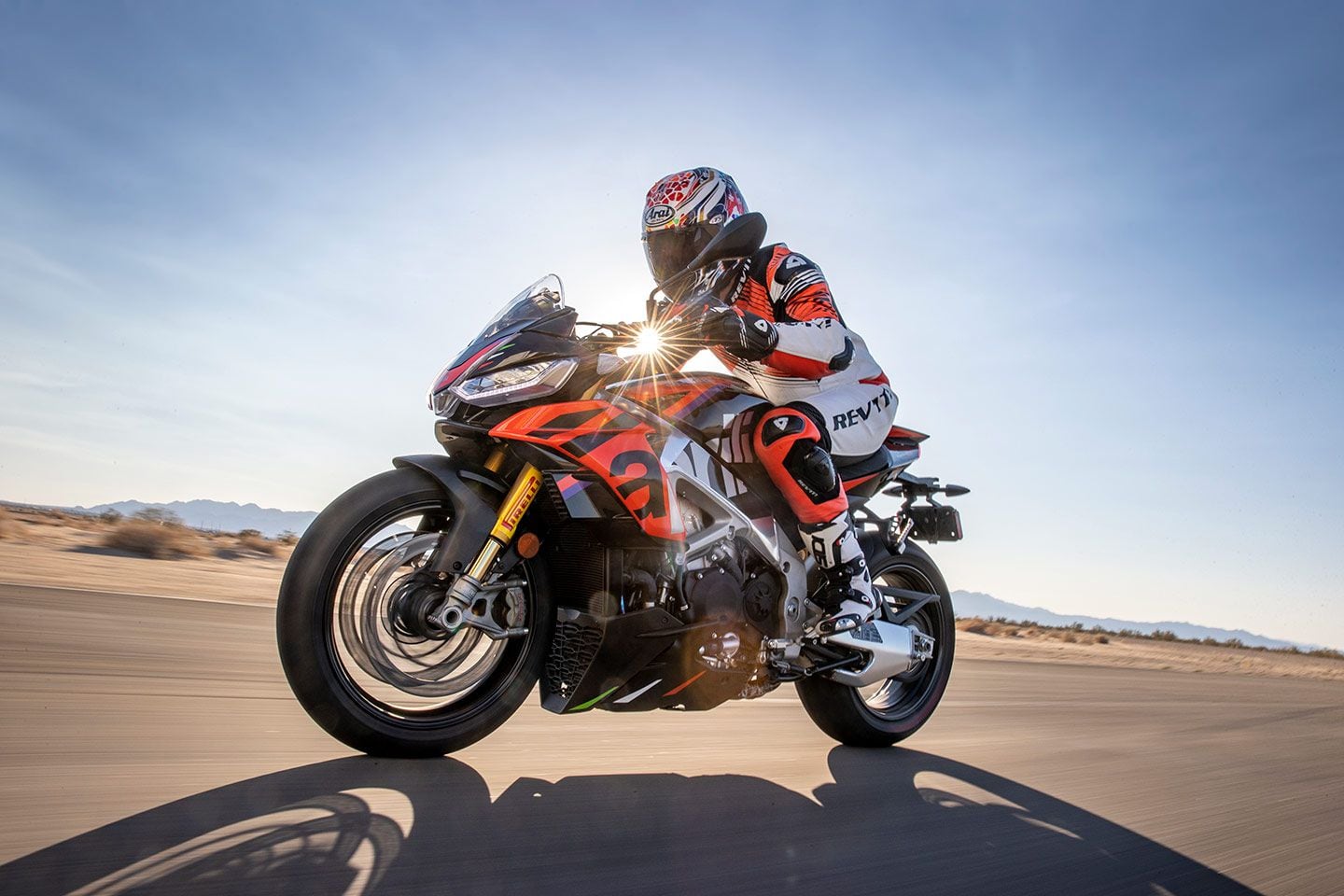 Aprilia’s Tuono V4 Factory offers the most extreme riding position of the trio. (Jeff Allen/)The Tuono’s riding position is the most cramped and aggressive. The high footpeg position and sloping seat are right off the RSV4, and yet it has the high handlebar. On the street, this can be a killer after a long day in the saddle, especially because the locked-in cockpit doesn’t allow you to move around very much, but it makes more sense on the racetrack. In a contradictory twist, the Tuono’s bikini fairing offers the best protection from the wind. 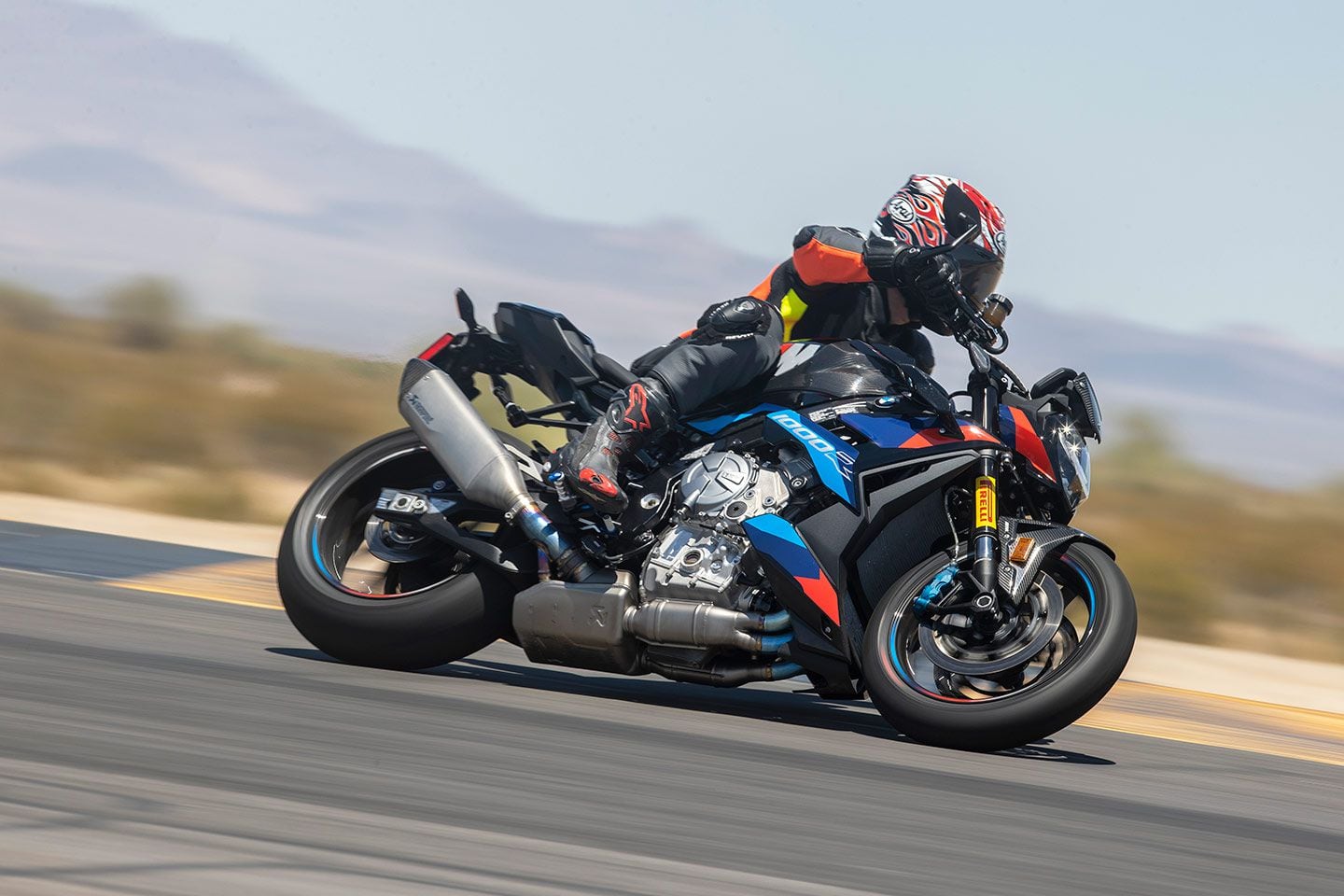 Overall, the M 1000 R’s riding position falls right in between the other two bikes. (Jeff Allen/)Like the Aprilia, the BMW has a few ergonomic challenges: “While the rider triangle is relatively relaxed, the M 1000 R’s low, flat handlebar puts weight on your wrists,” Adams said. When you’re ripping around the racetrack, this makes perfect sense, but after a few hours on the street you start to feel it in your arms. Shape and angle of the seat is nice, but it would be great if it were just a bit more plush, to help buy you a bit more comfort on a long ride. What little vibration this inline-four has can definitely be found here in the grips, and BMW’s bar-end mirrors may look stylish, but they vibrate enough at normal freeway speeds to render them completely useless. 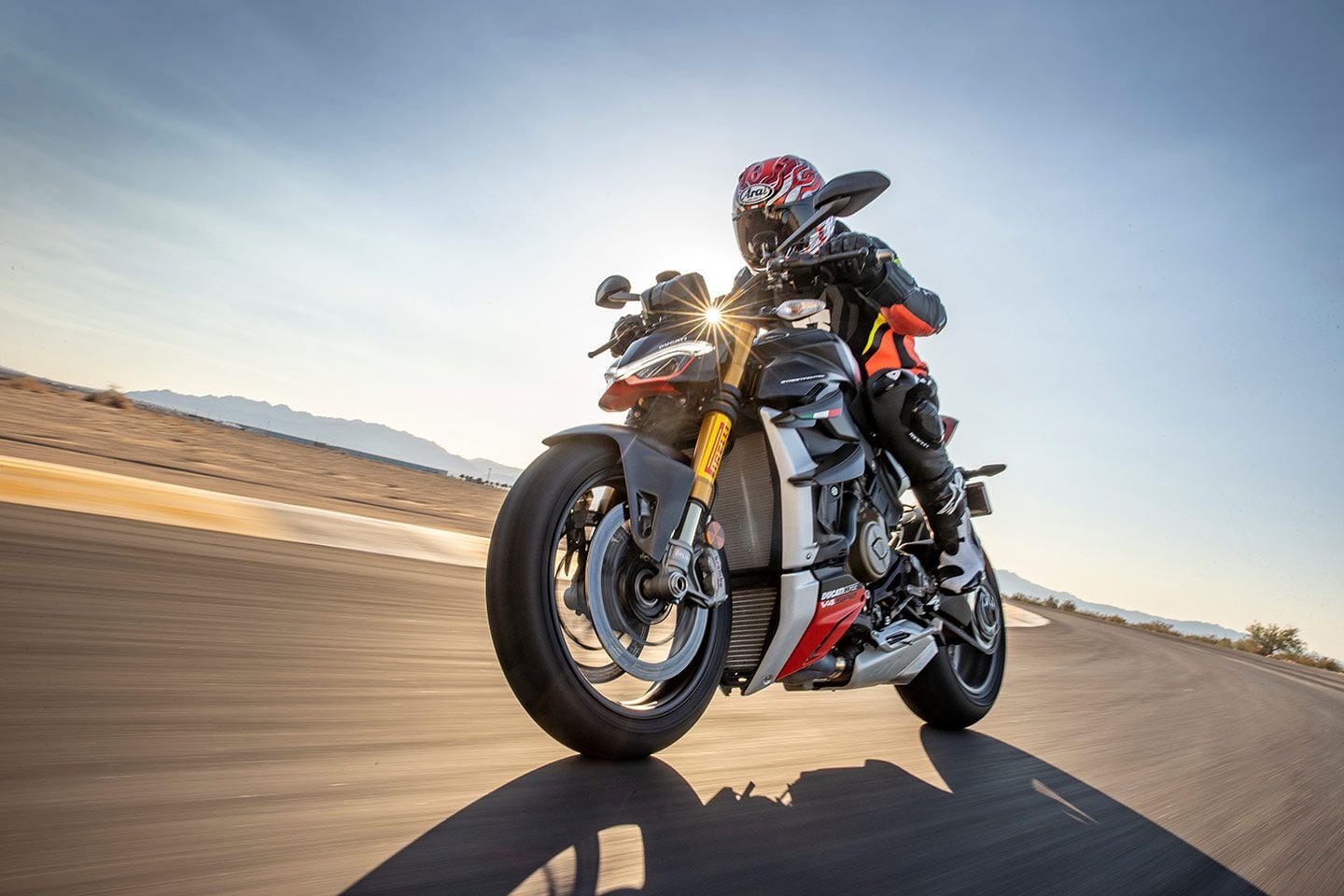 Not only is the Ducati amazingly comfortable on the street, it offers a good position for attacking the track as well. (Jeff Allen/)If you would have told us the Streetfighter V4 not only has a gnarly level of performance, but is also the most comfortable, we’d have bet the farm against it. But as it turns out, that’s 100 percent the case. It has a relaxed rider triangle and a relatively tall handlebar that makes the bike the most comfortable of the trio. The seat is the best of the group, offering the best padding and allowing the rider plenty of room to move around. You do get a bit of buffeting as there isn’t a windscreen, with the dash the only item breaking up the airflow to your upper body. On the street, especially after softening the damping, the Ducati is by far the most relaxed, and yet on the track the riding position worked just fine for attacking fast laps. Conclusion The hyper-naked landscape has been permanently changed by two of the bikes in this test, while the other has been the benchmark that all nakeds have been judged by for more than a decade. There has never been a duo with such raw performance as the BMW M 1000 R and Ducati Streetfighter V4 SP2. Unlike pretty much every other naked on the market, both companies delivered bikes that have in no way been dumbed down compared to the sportbikes they are based on. However, the Tuono gives up 35 hp to the RSV4. 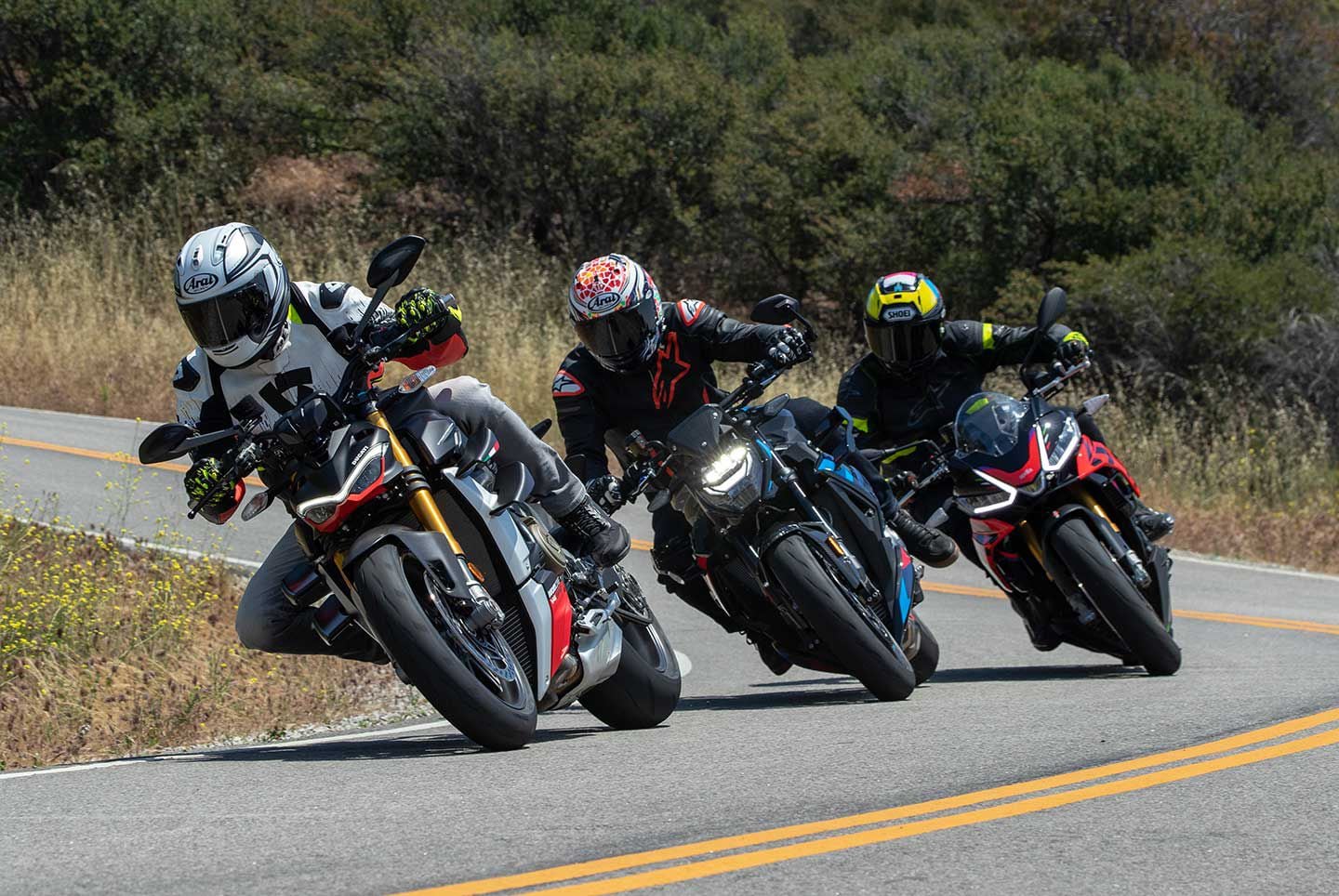 Two of these three bikes have changed everything we know about naked sportbikes, while the third was the bike that set the tone for a decade. (Kevin Wing/)Aprilia’s Tuono V4 Factory 1100 is still an amazing motorcycle that has stood the test of time and delivers a lot of smiles per mile. When we originally posed the question if the winner of our first part of the test, with bikes in the $20,000 range, could go head-to-head against the more expensive BMW and Ducati, we really didn’t know what the outcome would be. As it turns out, the answer is yes and no. The Tuono held its head high and was in no way embarrassed by its performance on the street and track. And it actually bested the BMW’s lap time at the track. But there’s a lot more to these bikes than on-track lap times. There are three things that hurt the Tuono: less comfort, less overall performance, and less-refined electronics that are falling behind the latest breed of sportbikes. Are those things that you can live with considering the fact that you can almost buy two Tuonos for the price of the Ducati? 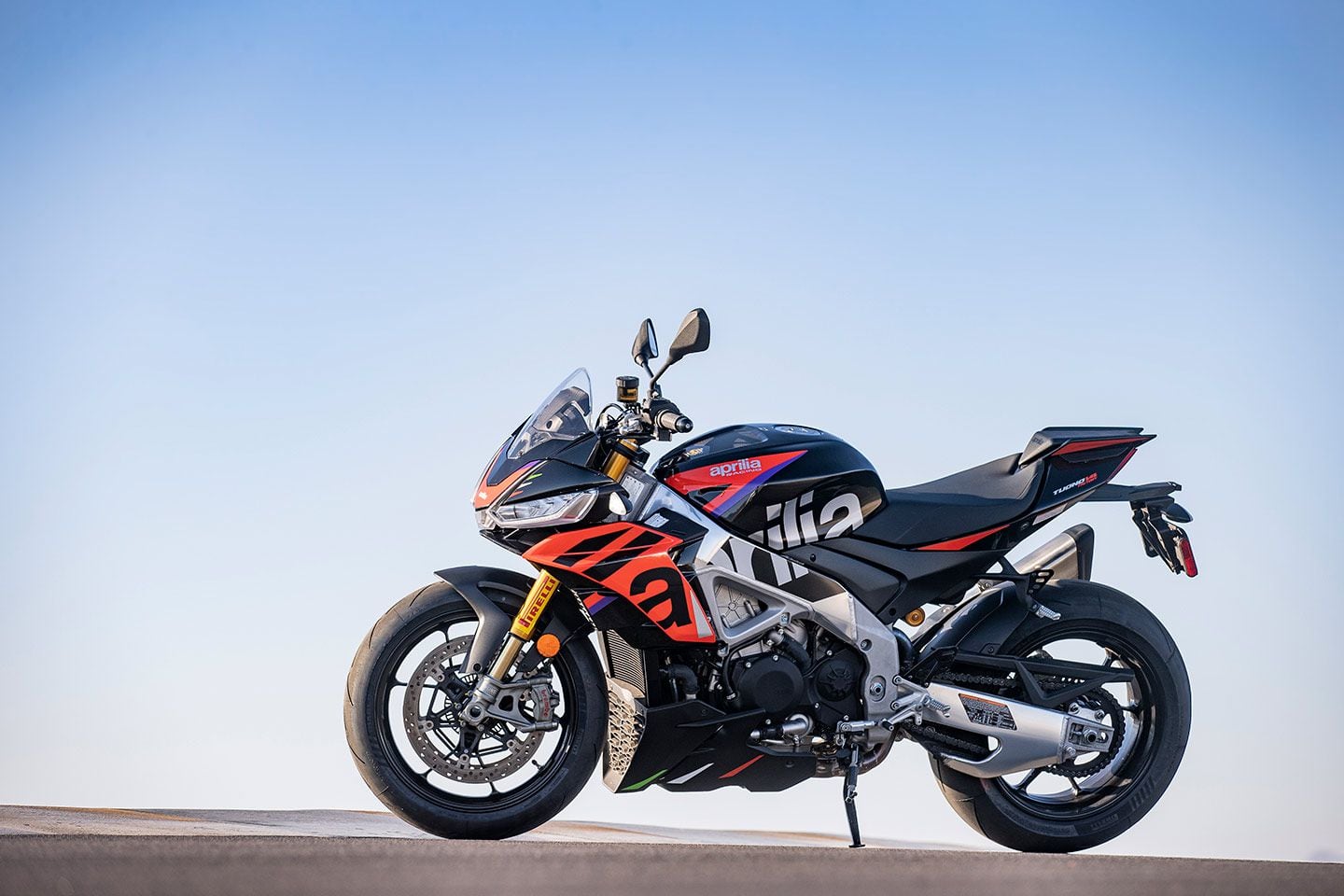 In the end, the Aprilia proved to be worthy of going head-to-head with the others, but ultimately came up just a bit short. (Jeff Allen/)Of all the bikes we’ve tested over the past few months, the BMW is perhaps the most frustrating. We should actually say the BMW’s engine as sold in the US disappointed us. The M has a sublime chassis both on the street and on the track. It’s the easiest bike to hop onto and be instantly at home from a handling perspective. And when you get the engine wound up into the top-end power the thing absolutely freaking rips. But the problem is that you have to get through the peaks and valleys of its power curves to find that incredible top-end. We hope to get our testbike back and try out the torque-optimization map, as that might be the solution we’re looking for. But as delivered, it’s the engine that held the M 1000 R back on the track and on the street as well. This bike has so much potential, and clearly there are solutions both at the dealership and aftermarket, but in bone-stock configuration, it comes up short in overall performance. 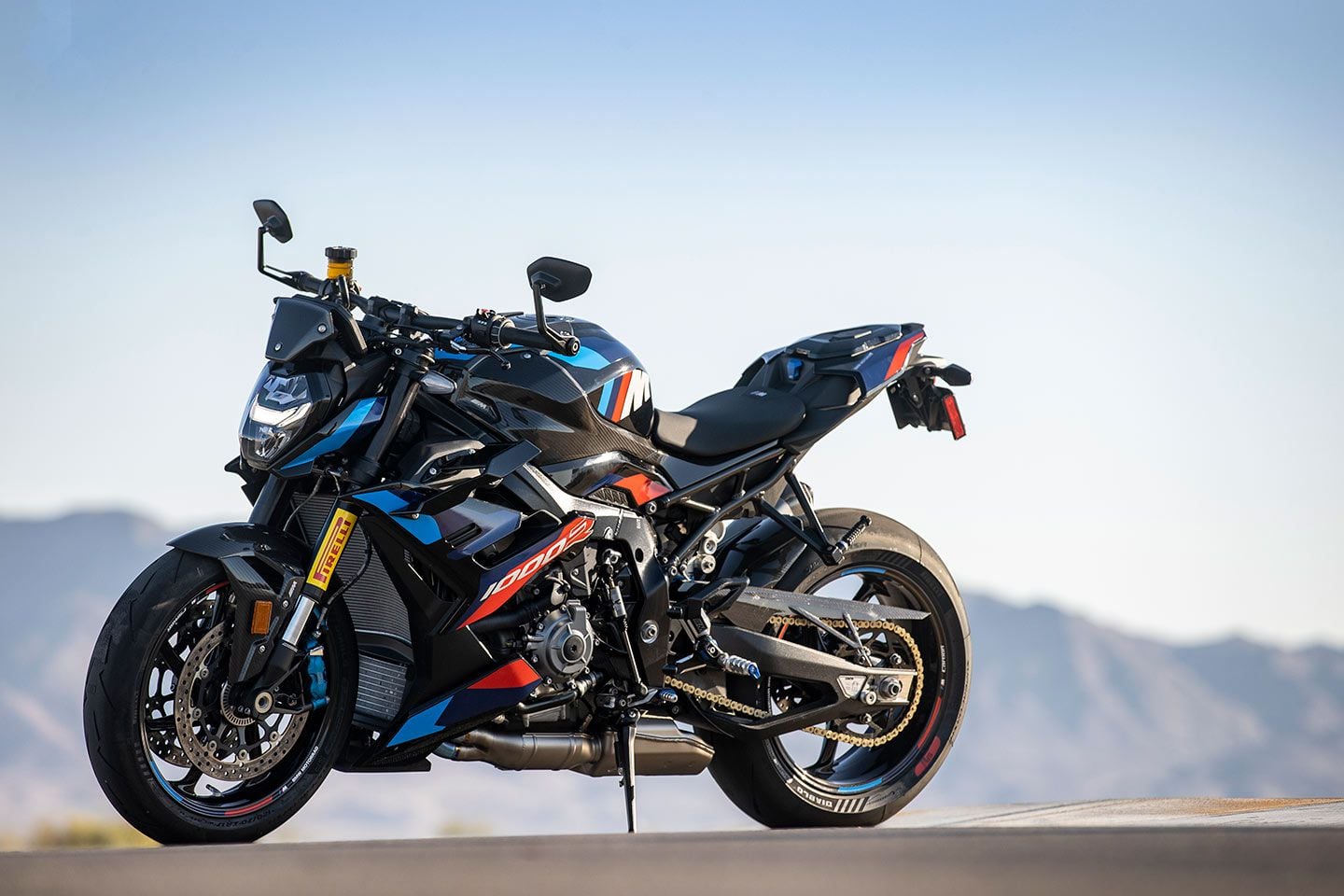 BMW’s M 1000 R has so many positive attributes, but ultimately was let down by the tuning of its engine. (Jeff Allen/)When we set out to find the best hyper-naked sportbike around, we really didn’t know what to expect. Part of the attraction to a naked like these is the added comfort that they offer over a sportbike, but to say that we were surprised by the Ducati’s comfort and practicality is a huge understatement. Never in a million years would we have guessed that the bike with the best overall engine performance, electronics package, and near-best chassis would also be the most practical and comfortable on a day-to-day basis. It’s a lot more than just icing on the cake. You may be able to buy two Tuonos for the price of the SP2, but don’t forget that the standard $22,095 Streetfighter V4 and $27,595 Streetfighter V4 S have the exact same engine and electronics. The key differences across the lineup is that the standard V4 doesn’t have the dry clutch, carbon wheels, and Öhlins semi-active suspension. 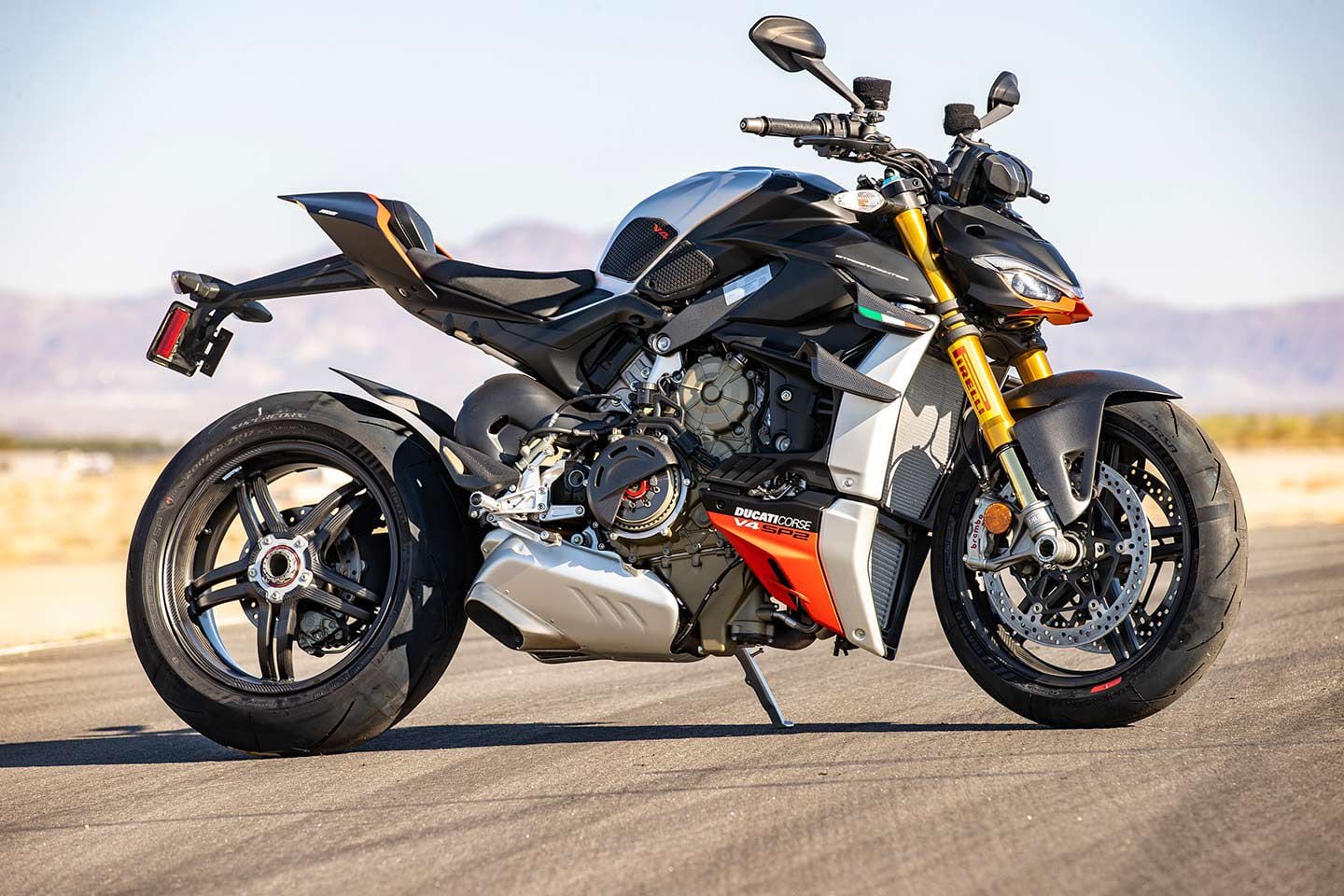 If you’re looking for the most potent, comfortable, refined, and amazing performing hyper-naked sportbike on the market, it’s the Ducati Streetfighter V4 SP2. (Jeff Allen/)Our task, however, was always to find the most potent hyper-naked on the market today, and that bike without question is Ducati’s Streetfighter V4 SP2. 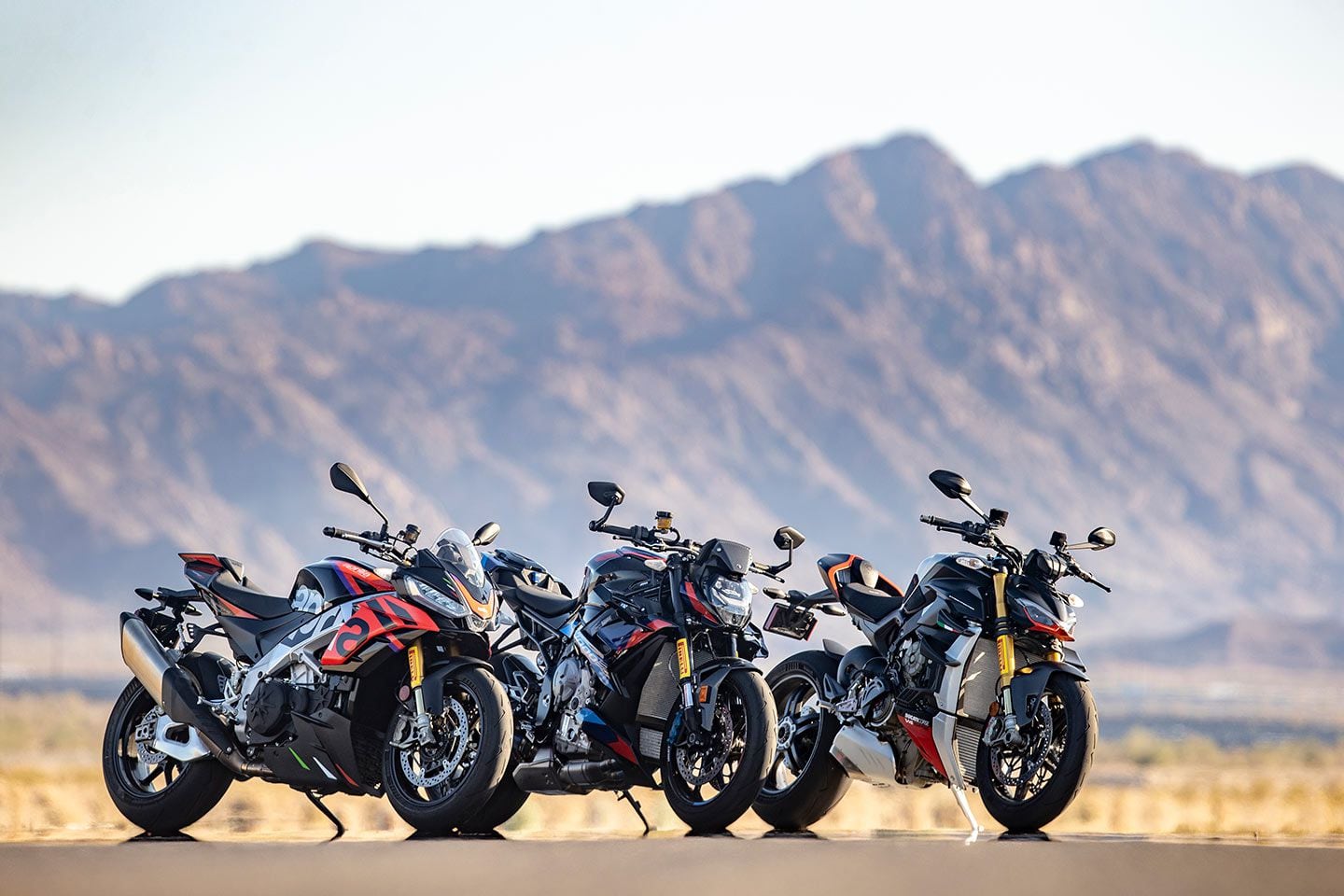 It was a good battle, but the Ducati clearly outshined the other contenders. (Jeff Allen/) 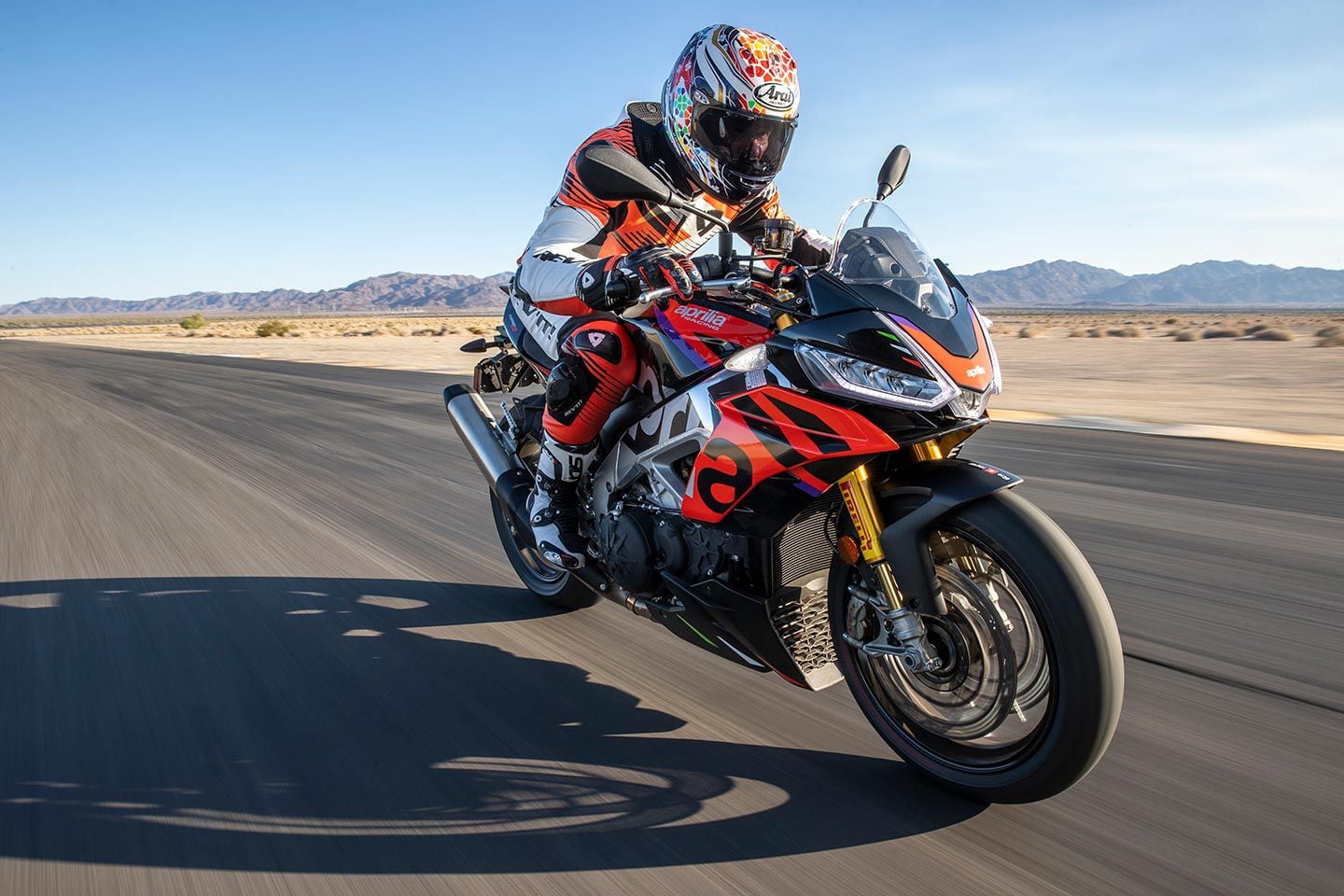 The Aprilia is basically a RSV4 with an upright bar and mellower engine tuning. (Jeff Allen/) 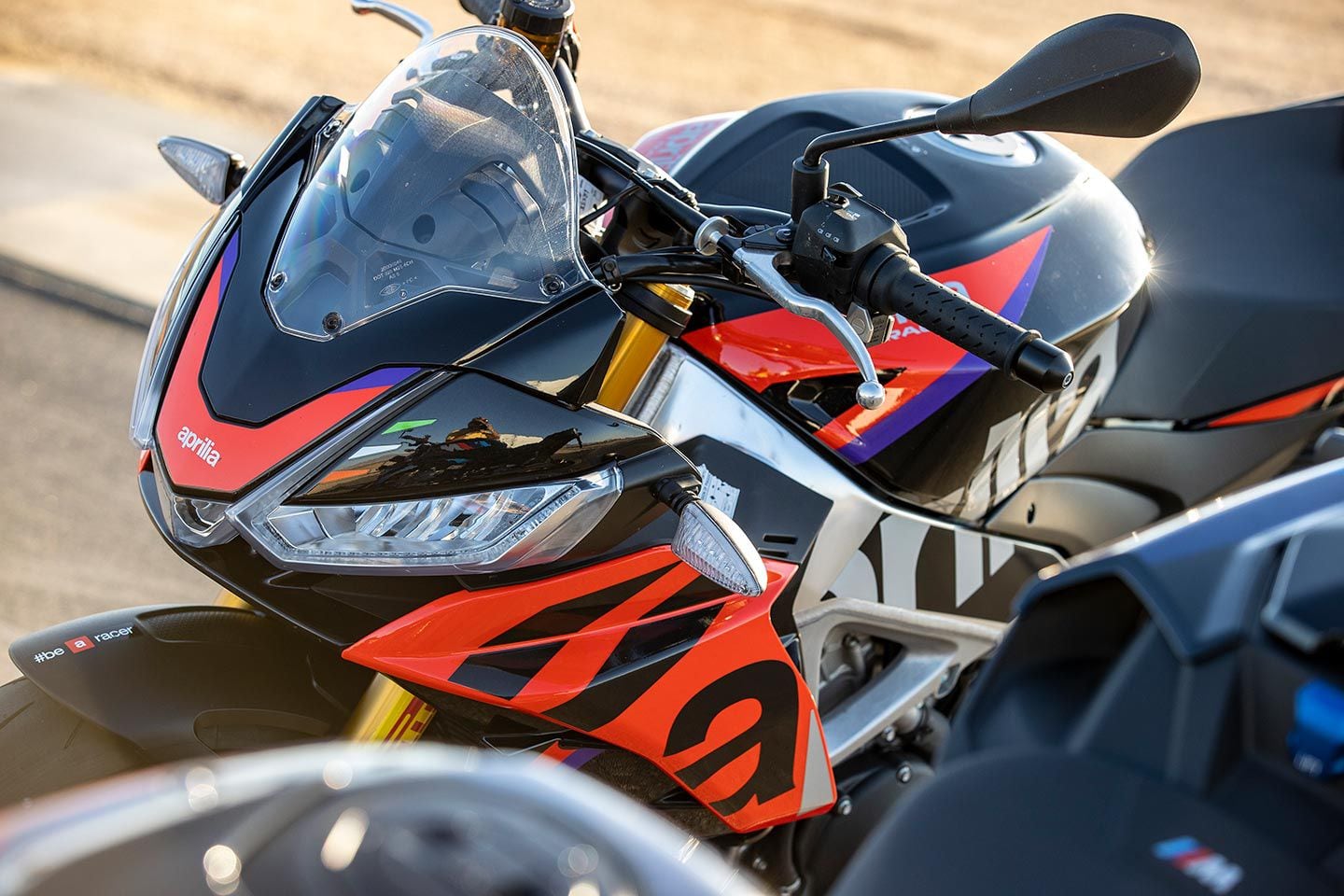 If you care if your “naked” has wind protection, the Tuono’s is the best. (Jeff Allen/) 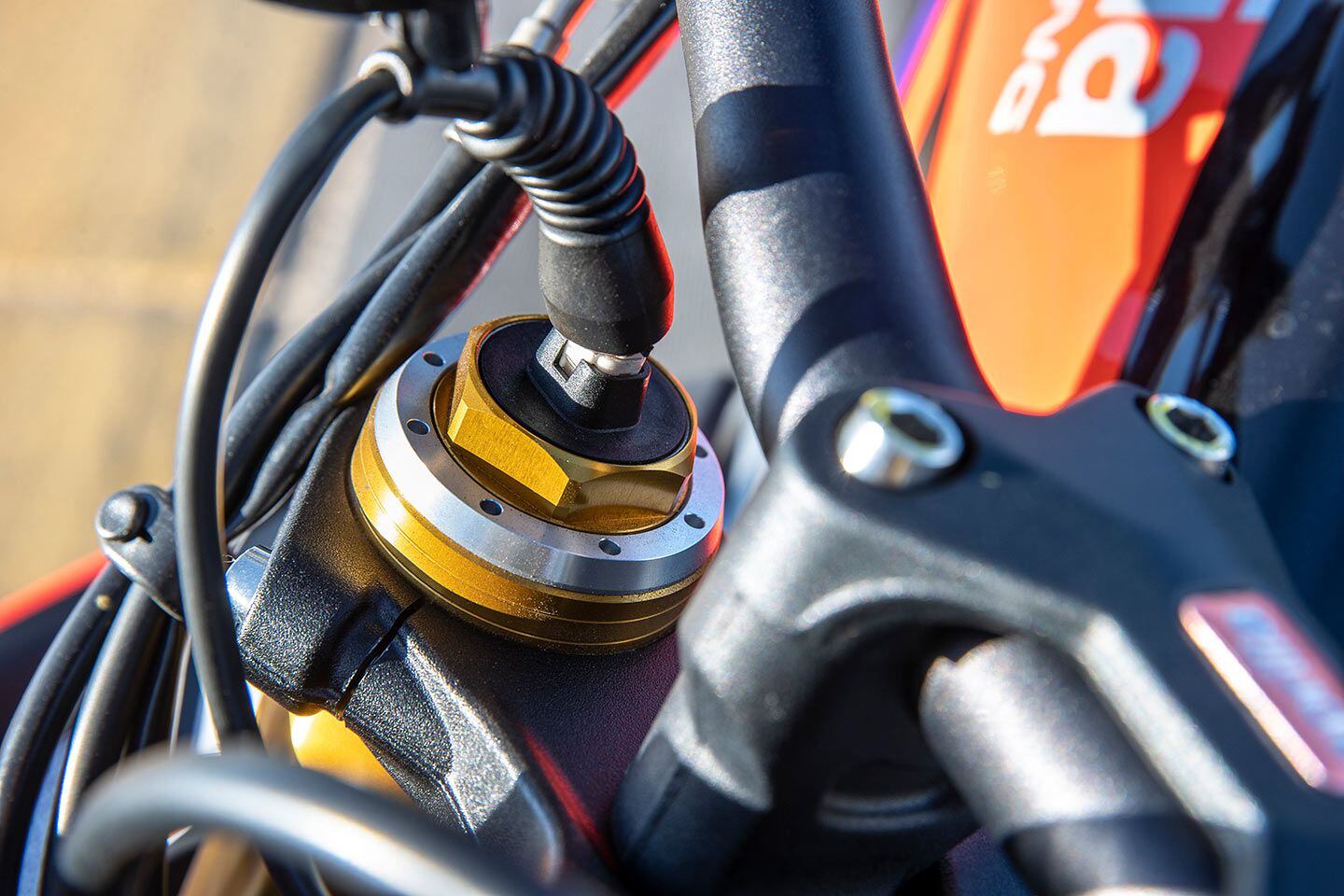 Aprilia’s Öhlins semi-active suspension. (Jeff Allen/) 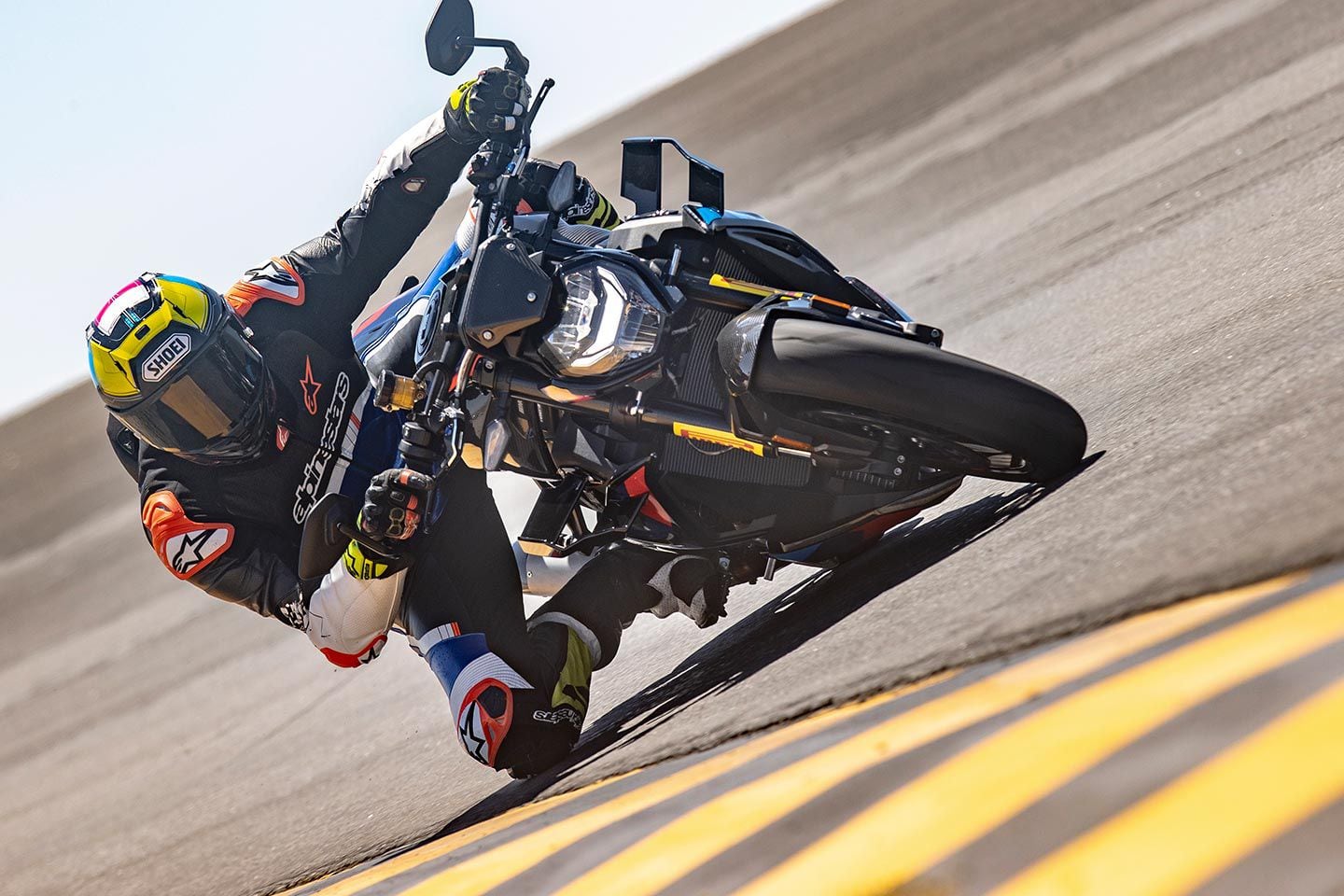 We all agreed that the BMW chassis was our favorite. (Jeff Allen/) 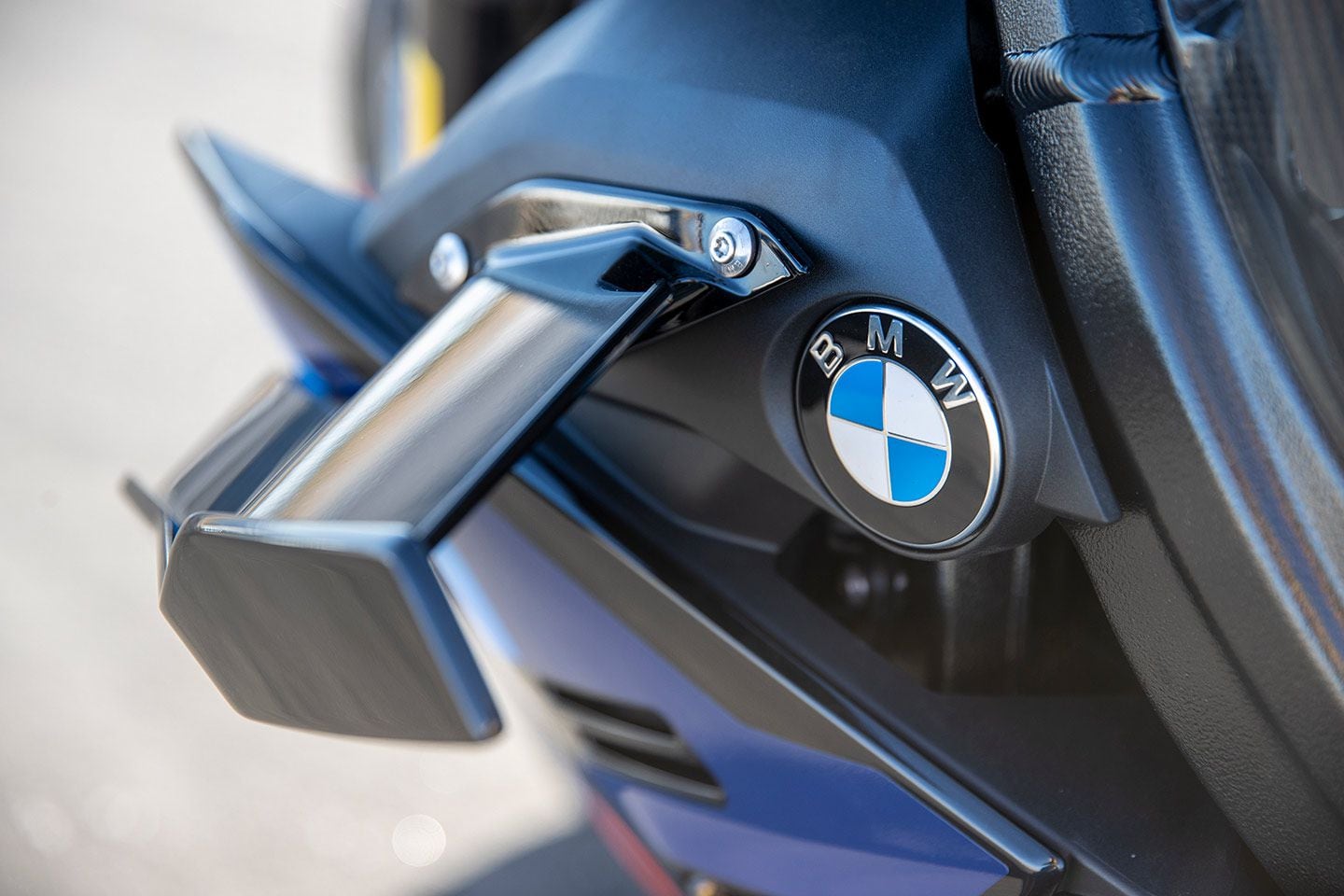 Winglets have found their way onto the M 1000 R. Which is the reason BMW hasn’t reduced the peak power of the R versus the RR donor bike. (Jeff Allen/) 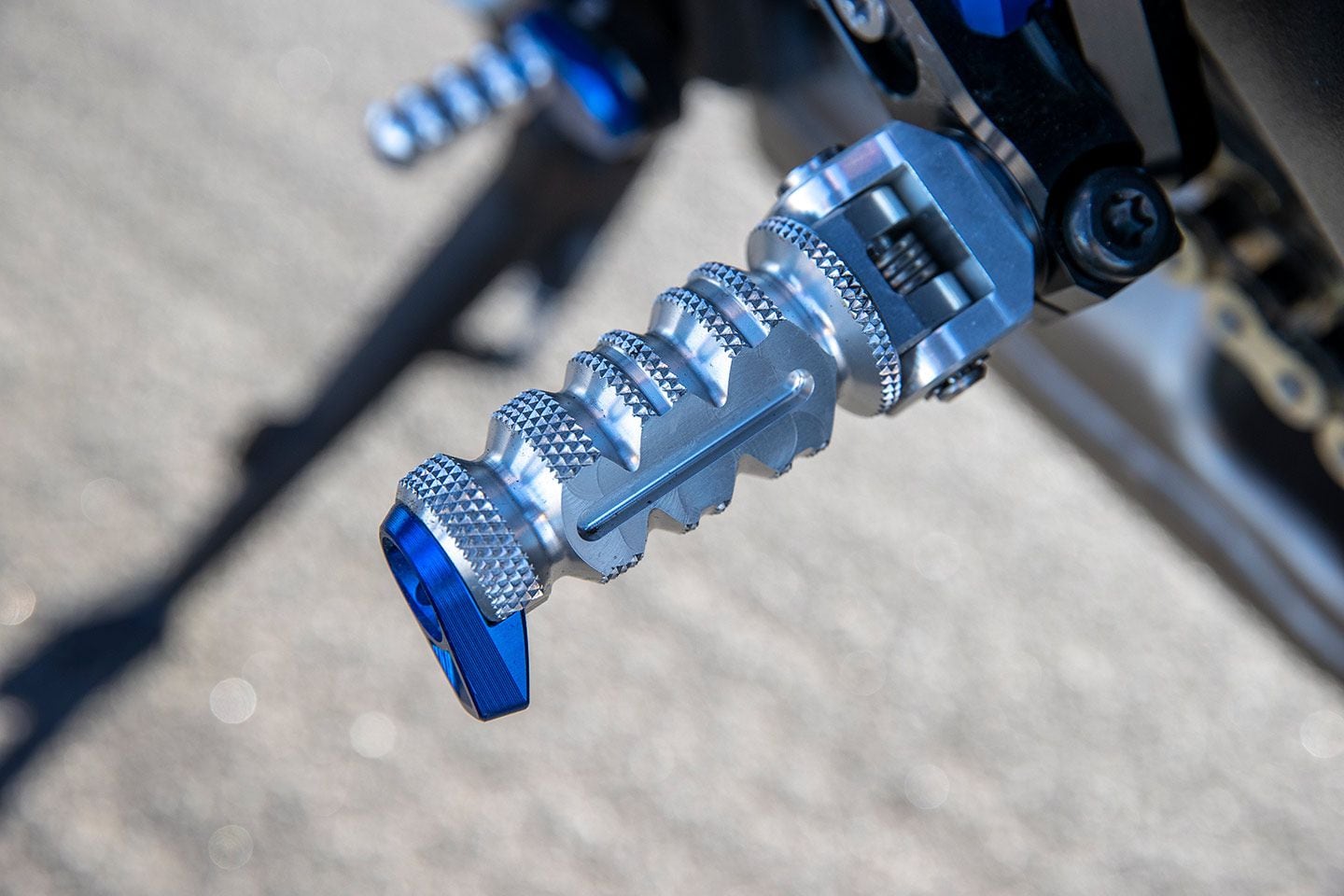 The M comes with trick and easily adjustable rearsets. (Jeff Allen/) 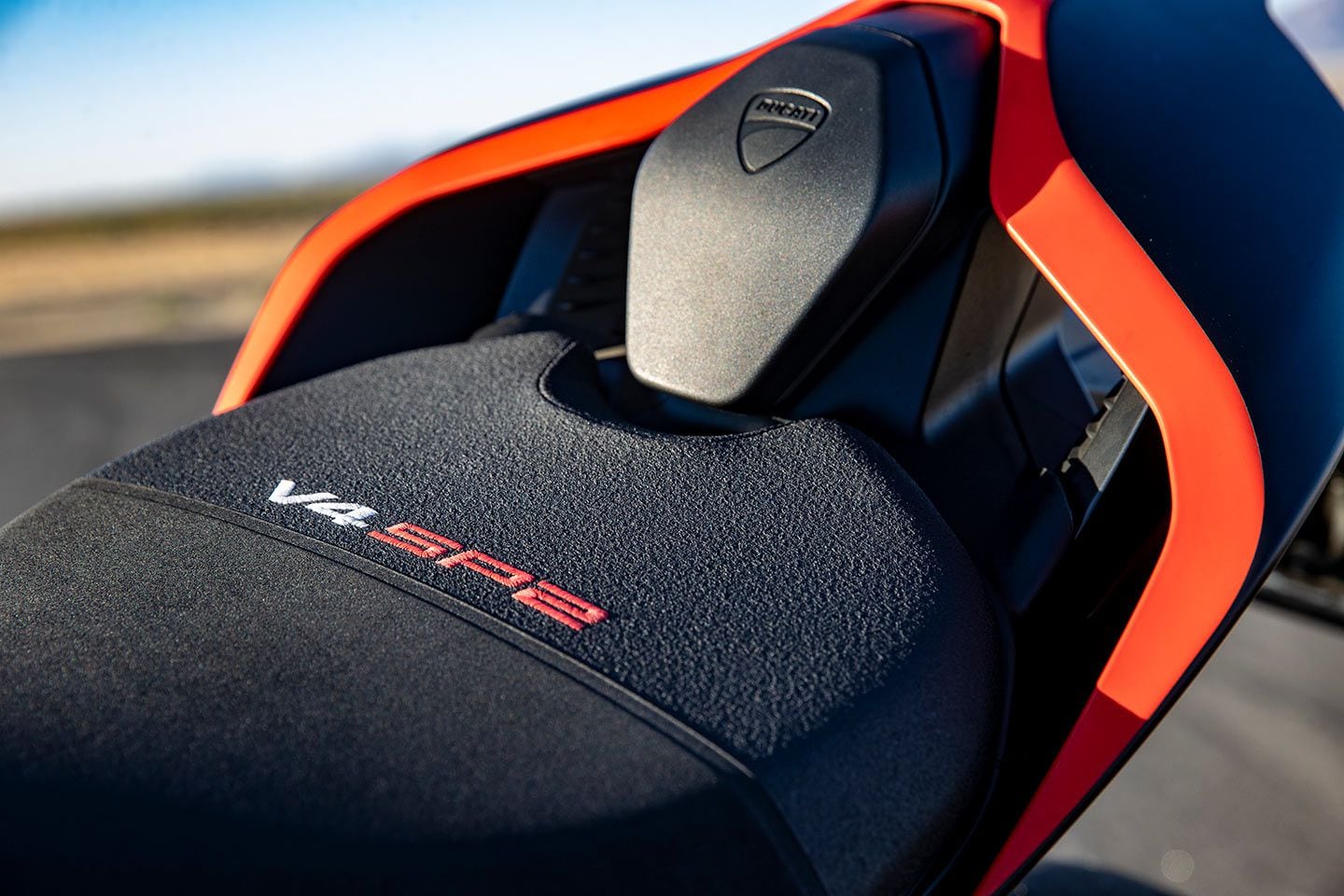 The Ducati proves that you don’t have to sacrifice comfort to get performance. This is the best seat of the batch. (Jeff Allen/) 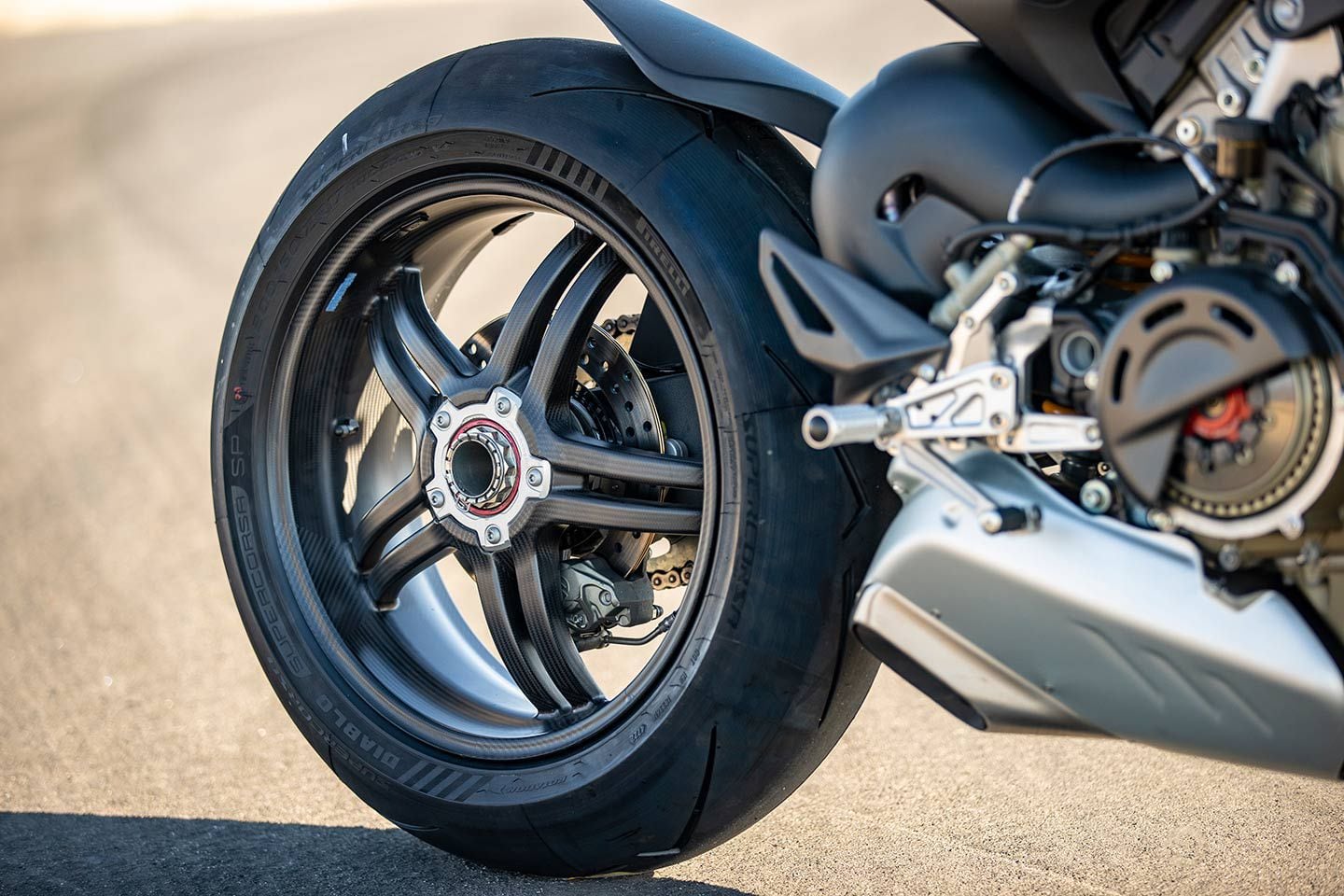 These beautiful carbon fiber wheels come standard on the SP2. (Jeff Allen/) 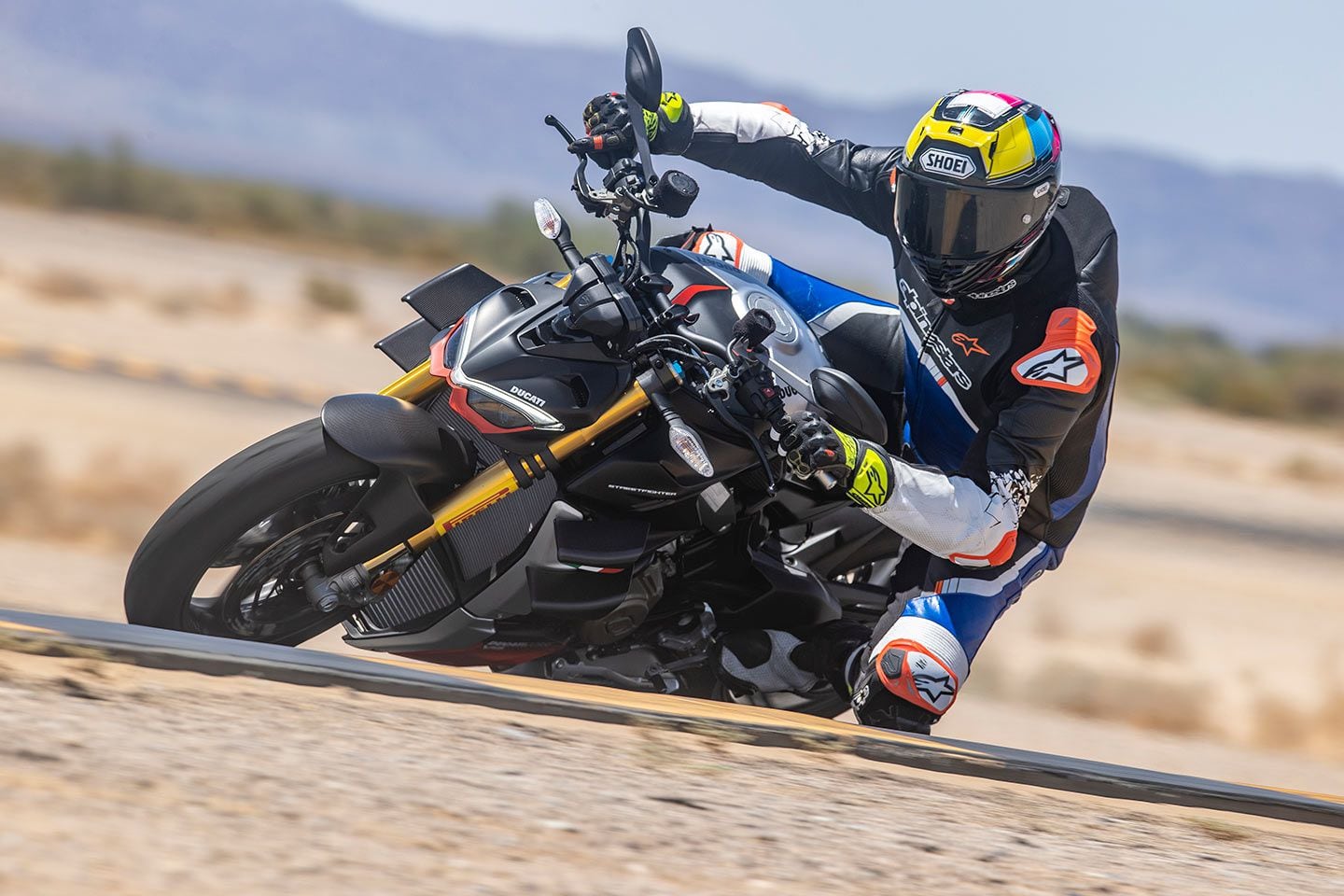 The Ducati took no prisoners by setting the fastest time of the test in a single flying lap. (Jeff Allen/) 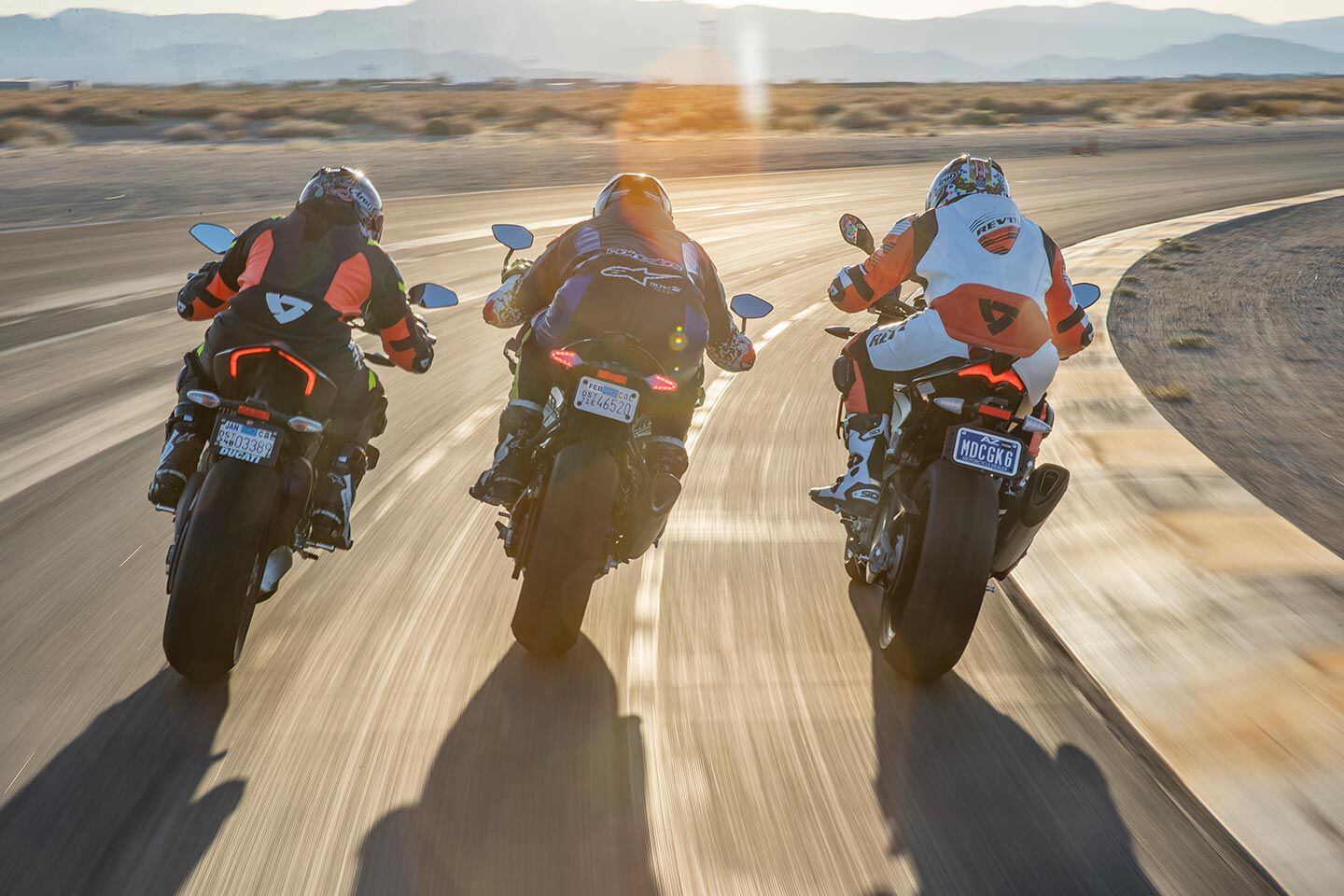 That’s all, folks, we’re outta here. (Jeff Allen/) 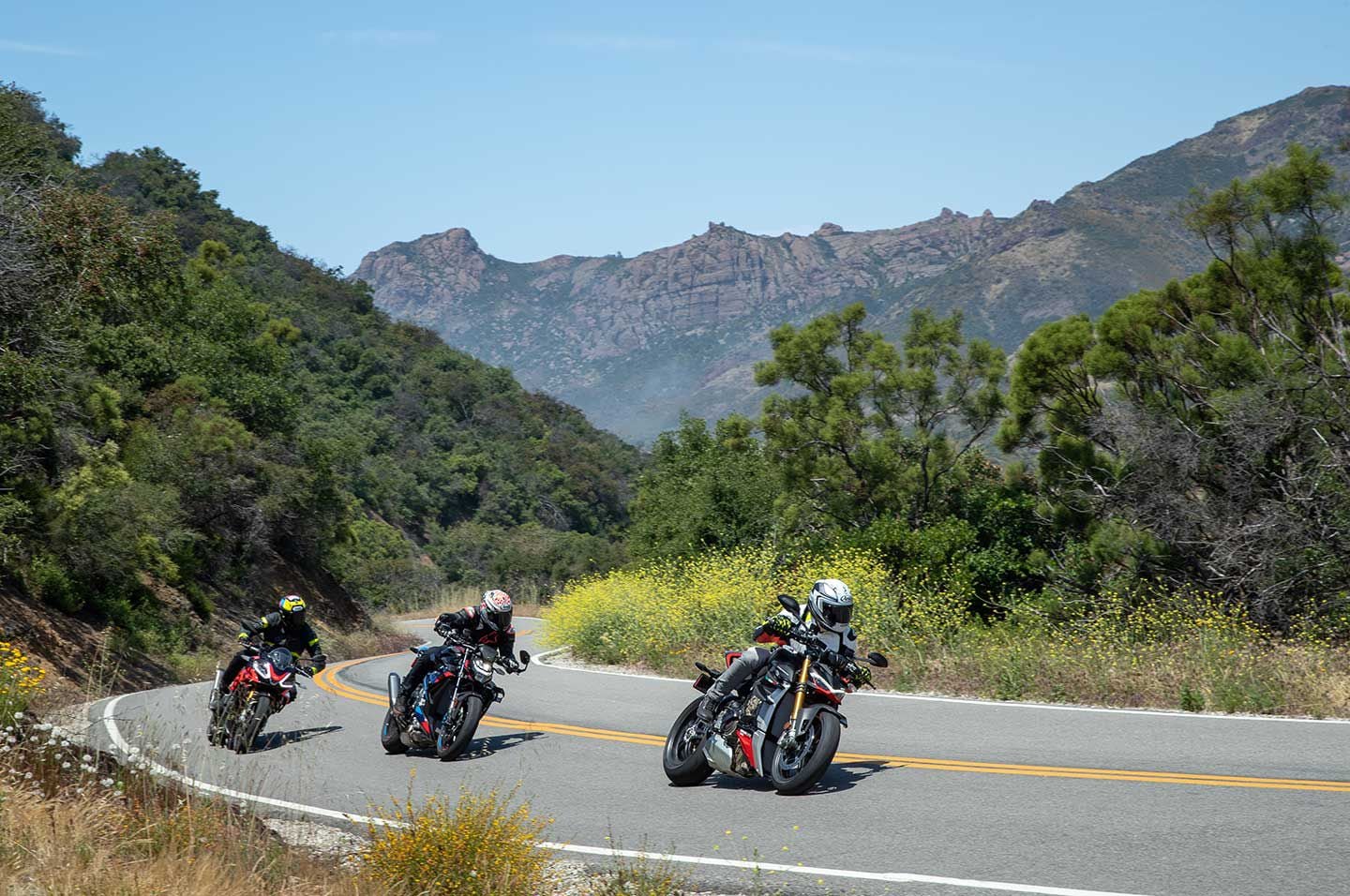 These three bikes are amazing on the street. (Kevin Wing/) 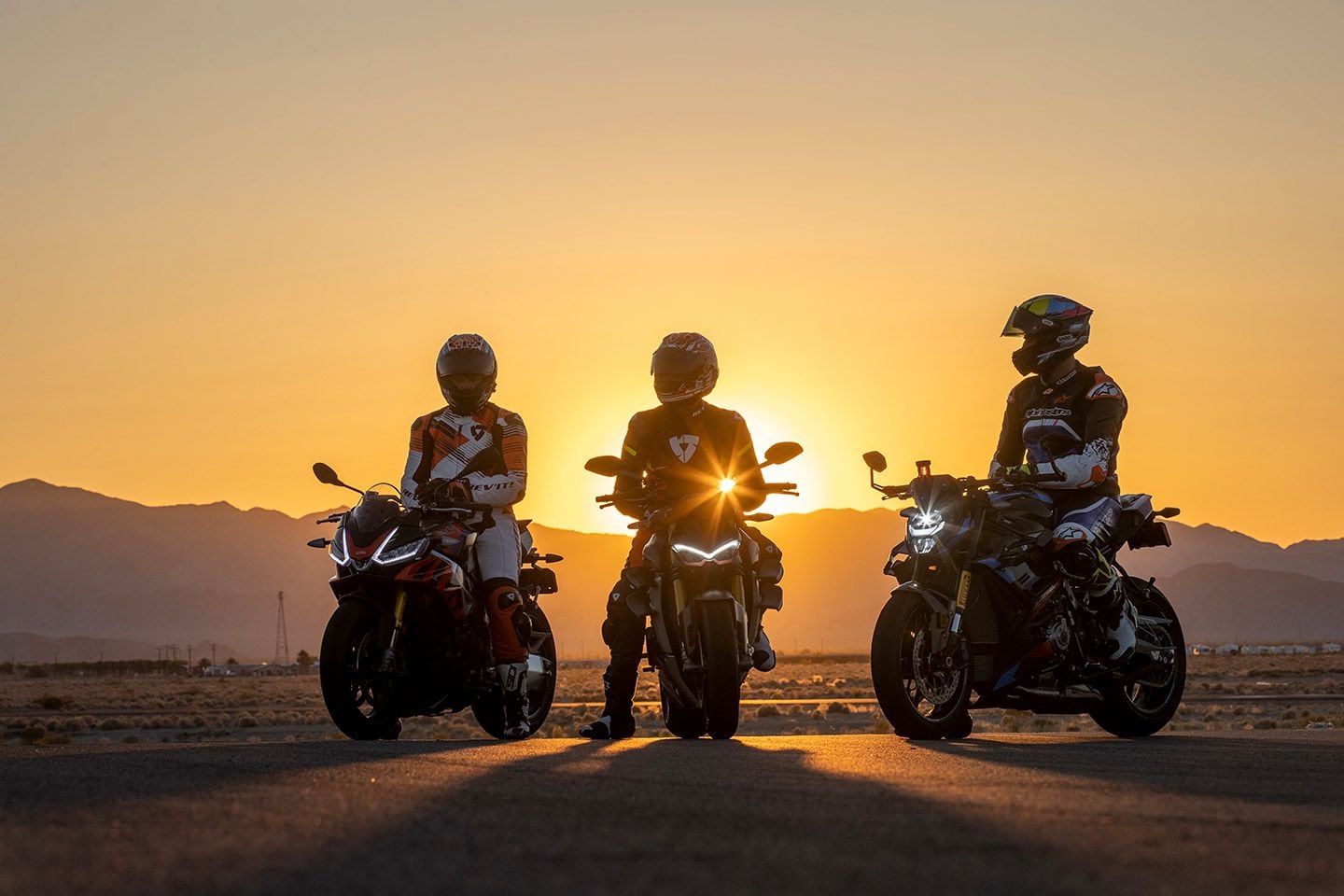 Up before sunrise and riding until sunset. (Jeff Allen/)Specifications 2023 Aprilia Tuono V4 Factory2023 BMW M 1000 R2023 Ducati Streetfighter V4 SP2MSRP:$19,599$27,640 (as tested)$37,995Engine:DOHC, liquid-cooled, four-stroke, 65-degree V-4; 4-valve/cyl.DOHC, liquid-cooled inline-four; 16 valvesLiquid-cooled Desmosedici Stradale 90-degree V-4, rearward-rotating crankshaft; 4 desmodromically actuated valves/cyl.Displacement:1,077cc999cc1,103ccBore x Stroke:81.0 x 52.3mm80.0 x 49.7mm81.0 x 53.5mmCompression Ratio:13.0:113.3:114.0:1Transmission/Final Drive:6-speed/chain6-speed/chain6-speed/chainCycle World Measured Horsepower:154.5 hp @ 11,500 rpm185.1 hp @ 13,400 rpm172.8 hp @ 13,500 rpmCycle World Measured Torque:80.2 lb.-ft. @ 9,200 rpm76.2 lb.-ft. @ 10,300 rpm75.2 lb.-ft. @ 9,300 rpmFuel System:Fuel injection w/ Marelli 48mm throttle bodies, ride-by-wireElectronic fuel injection w/ 48mm throttle bodiesElectronic fuel injection w/ elliptical throttle bodiesClutch:Wet, multiplate slipper/assistWet, multi-disc back-torque-limiting; cable actuatedDry, multiplate STM slipper and self-servo; hydraulically actuatedEngine Management/Ignition:Magneti Marelli digital electronic ignition systemRide-by-wire/TCIN/AFrame:Aluminum dual beamTwin-spar aluminumAluminum alloyFront Suspension:43mm Öhlins EC NIX fork, fully adjustable; 4.7 in. travel45mm Marzocchi inverted fork, fully adjustable; 4.7 in. travel / DDC43mm Öhlins NIX 30 w/ electronically adjustable compression and rebound damping; 4.7 in. travelRear Suspension:Öhlins EC shock, fully adjustable; 5.1 in. travelMarzocchi shock, fully adjustable; 4.6 in. travel / DDCÖhlins TTX 36 w/ electronically adjustable compression and rebound damping; 5.1 in. travelFront Brake:Radial Brembo M50 4-piston calipers, dual floating 330mm discs w/ Cornering ABSNissin 4-piston Monoblock calipers, dual 320mm discs w/ ABSBrembo 4-piston Stylema Monoblock caliper, dual 330mm discs w/ Cornering ABS EvoRear Brake: Brembo 2-piston floating caliper, 220mm disc w/ Cornering ABSBrembo 1-piston slide-pin caliper, 220mm disc w/ ABS2-piston floating caliper, 245mm disc w/ Cornering ABS EvoWheels, Front/Rear:Cast alloy; 17 x 3.5 in. / 17 x 6.0 in.Forged aluminum; 17 x 3.50 in. / 17 x 6.00 in.5-spoke carbon fiber; 17 x 3.50 in. / 17 x 6.00 in.Tires, Front/Rear:Pirelli Diablo Supercorsa; 120/70-17, 200/55-17120/70ZR-17 / 200/55ZR-17Pirelli Diablo Rosso IV Corsa; 120/70-17 / 200/60-17Rake/Trail:24.7°/3.9 in.24.0°/3.8 in.24.5°/4.0 in.Wheelbase:56.9 in.57.1 in.58.6 in.Ground Clearance:N/AN/AN/ASeat Height:32.4 in.33.1 in.33.3 in.Fuel Capacity:4.8 gal.4.4 gal.4.5 gal.Average MPG:29.0 mpgN/AN/ACycle World Measured Wet Weight:470 lb.437 lb.451 lb.Contact:aprilia.combmwmotorcycles.comducati.com CW Measured Performance 2023 Aprilia Tuono V4 Factory2023 BMW M 1000 R2023 Ducati Streetfighter V4 SP2Quarter-Mile:10.57 sec. @ 141.17 mph10.33 sec. @ 145.39 mph10.38 sec. @ 145.11 mph0–30:1.48 sec.1.57 sec.1.56 sec.0–60:2.99 sec.3.01 sec.3.08 sec.0–100:5.79 sec.5.52 sec.5.47 sec.Braking, 30–0:29.49 ft.30.35 ft.31.28 ft.Braking, 60–0:115.43 ft.120.23 ft.122.87 ft.
__________________________________________________
I'm a bot. I don't need no stinkin' signature... |
|
|

|
 |
 Similar Threads
Similar Threads
|
||||
| Thread | Thread Starter | Forum | Replies | Last Post |
| [cycleworld.com] - How Much Power Does the 2023 Aprilia Tuono V4 Factory 1100 Make? | Ninjette Newsbot | Motorcycling News | 0 | July 26th, 2023 12:17 PM |
| [cycleworld.com] - Aprilia Tuono V4 Factory vs. KTM 1290 Super Duke R Evo vs. Yamaha | Ninjette Newsbot | Motorcycling News | 0 | June 7th, 2023 11:12 AM |
| [cycleworld.com] - Superbike Shootout: Aprilia RSV4 Factory vs. BMW M 1000 RR vs. Duc | Ninjette Newsbot | Motorcycling News | 0 | December 30th, 2022 12:14 PM |
| [roadracingworld.com] - Bike Intro: 2022 Aprilia Tuono V4 & Tuono V4 Factory, In The | Ninjette Newsbot | Motorcycling News | 0 | September 28th, 2021 06:39 AM |
| [faster and faster] - Streetfighter Shootout: Aprilia Tuono Factory vs Ducati Monster | Ninjette Newsbot | Motorcycling News | 0 | August 3rd, 2016 09:10 AM |
|
|